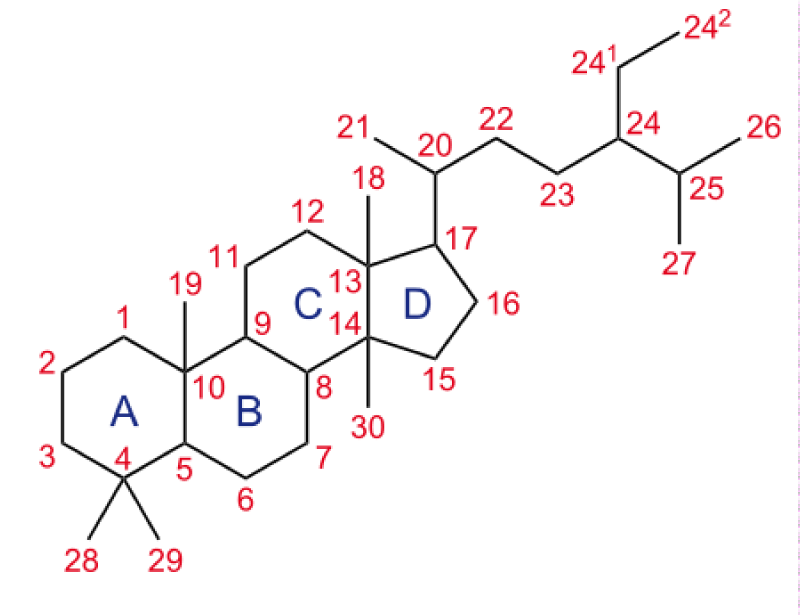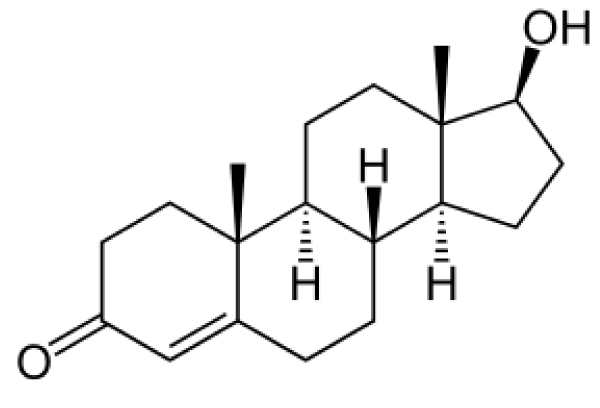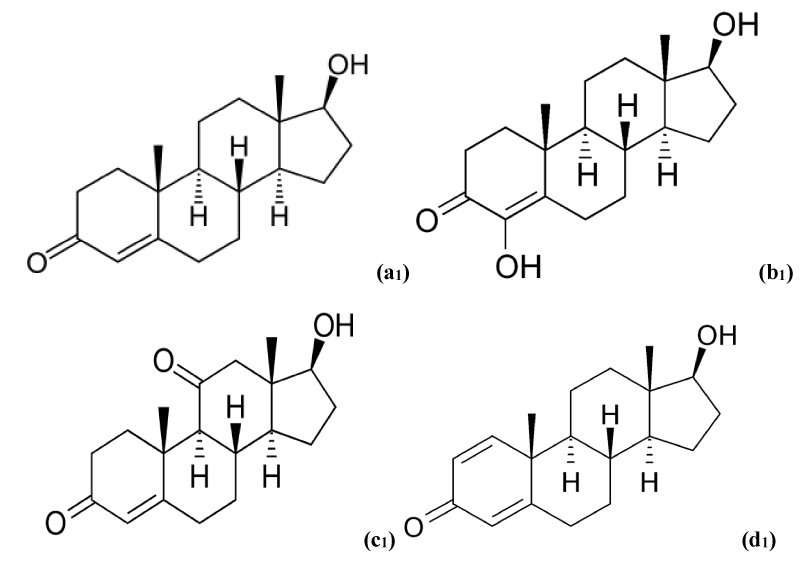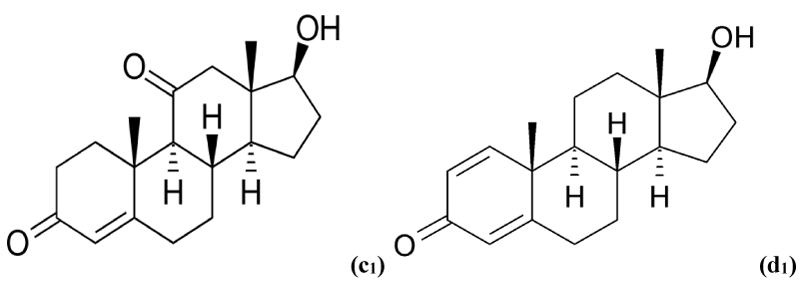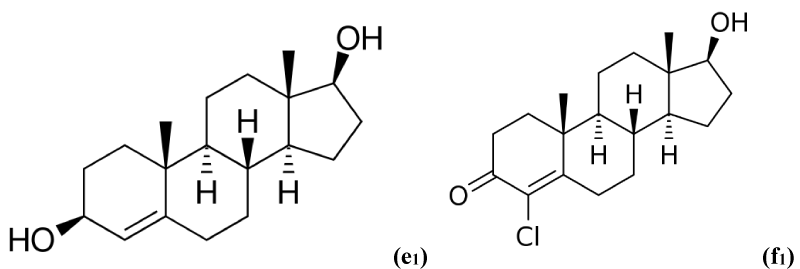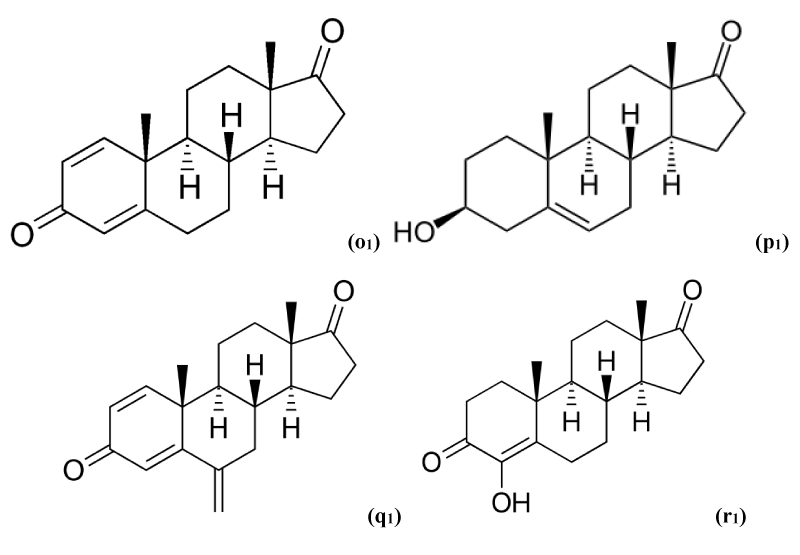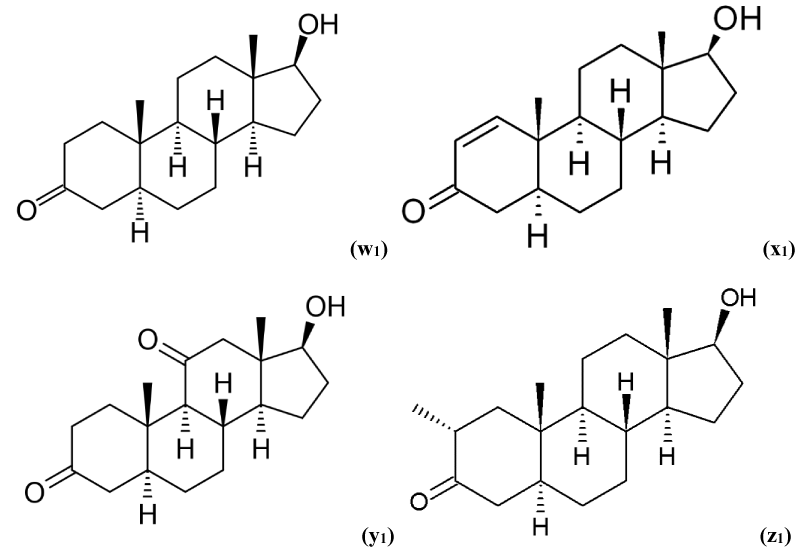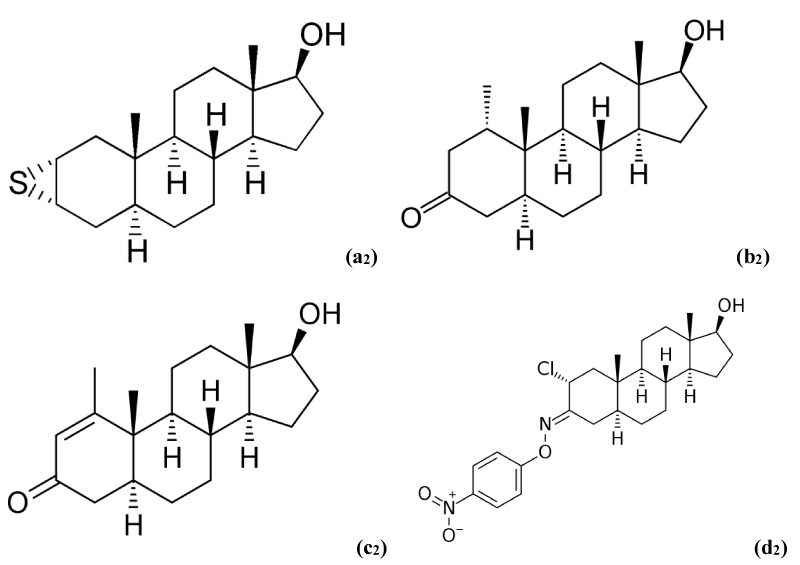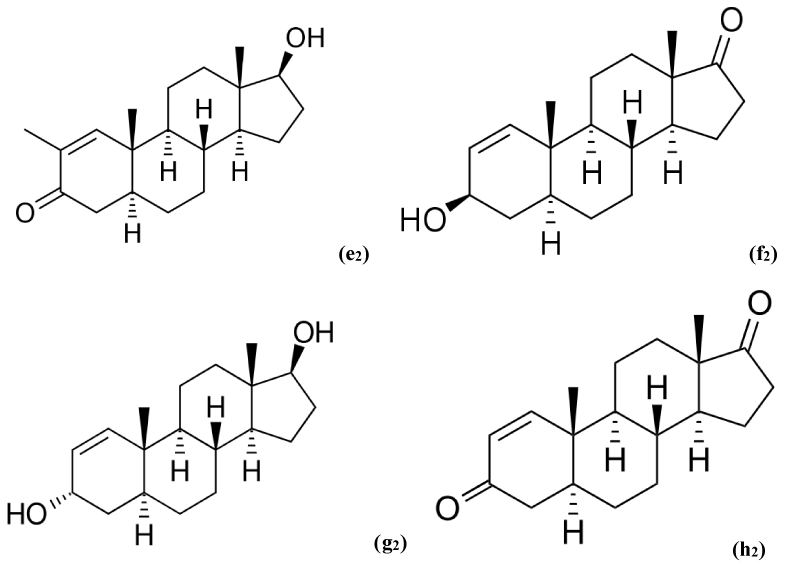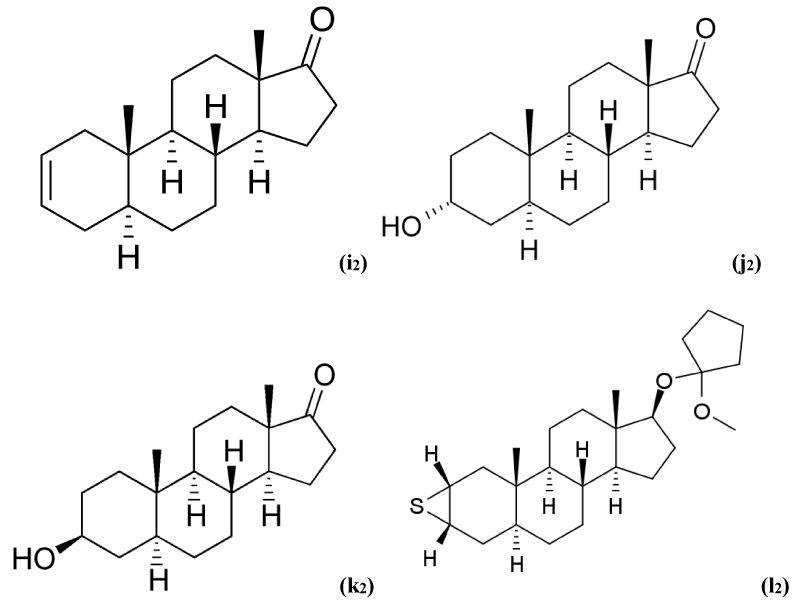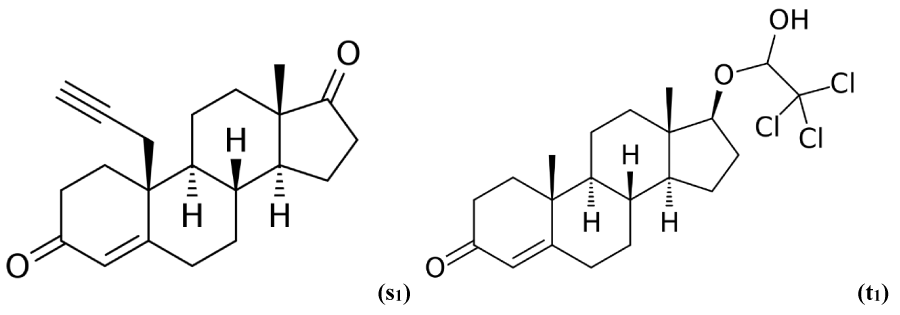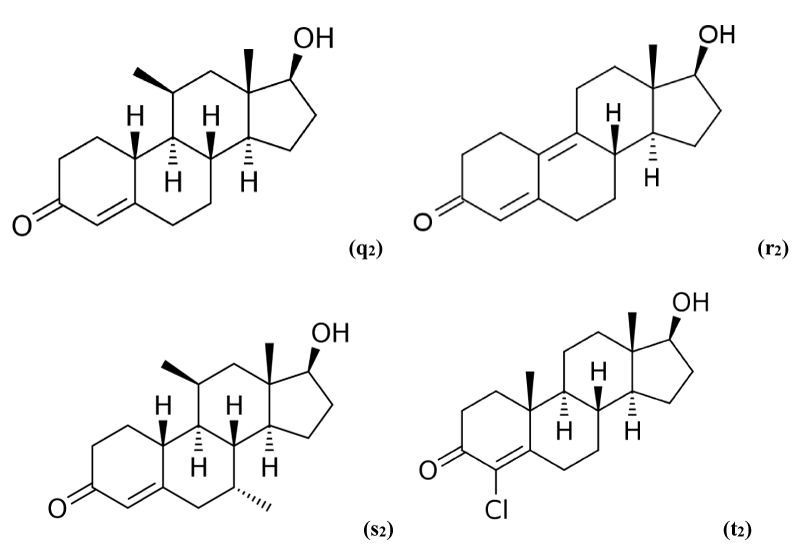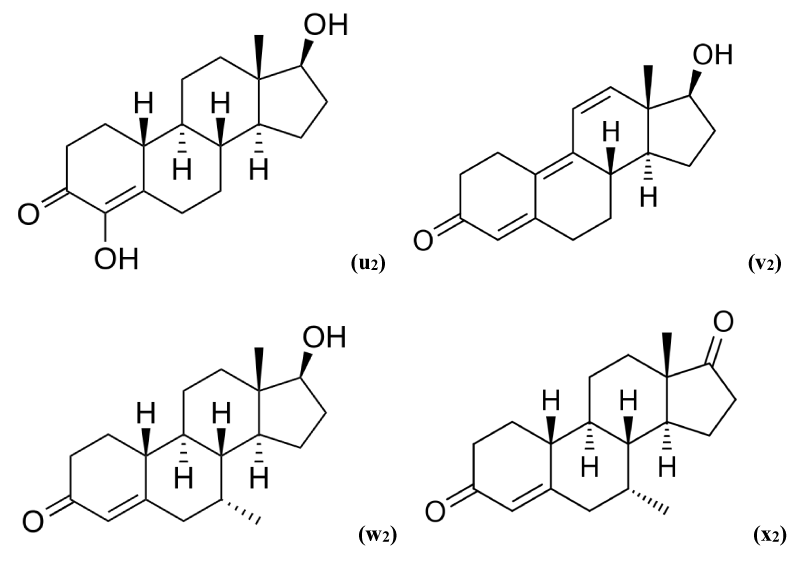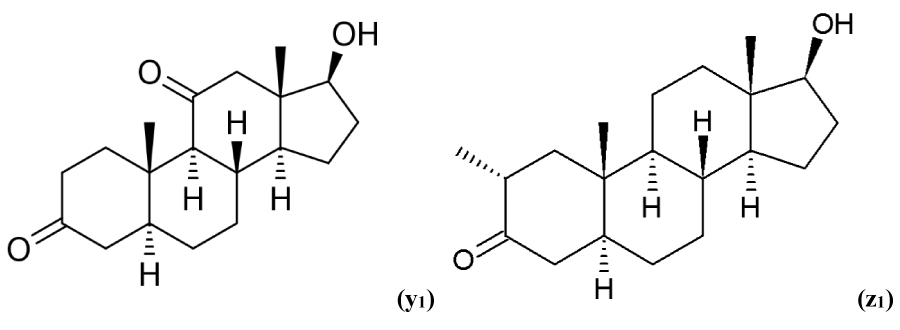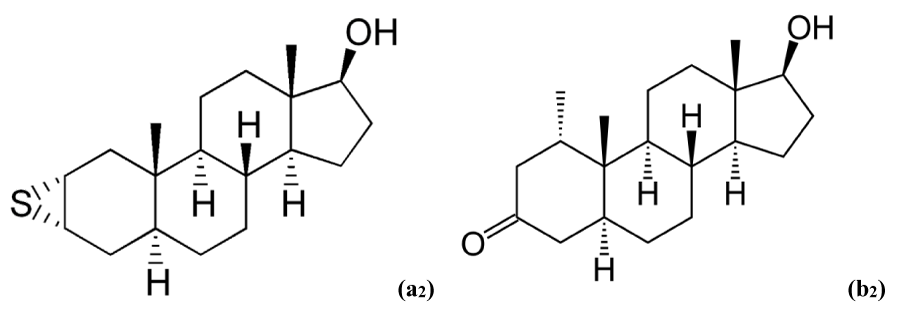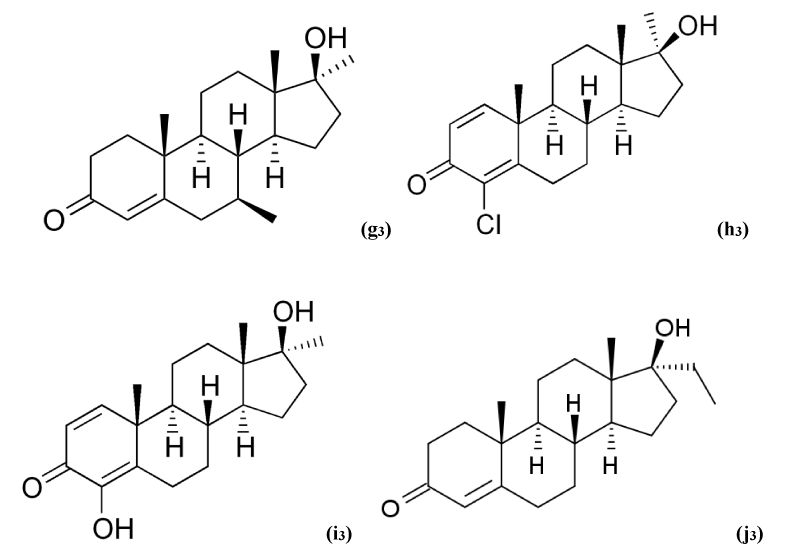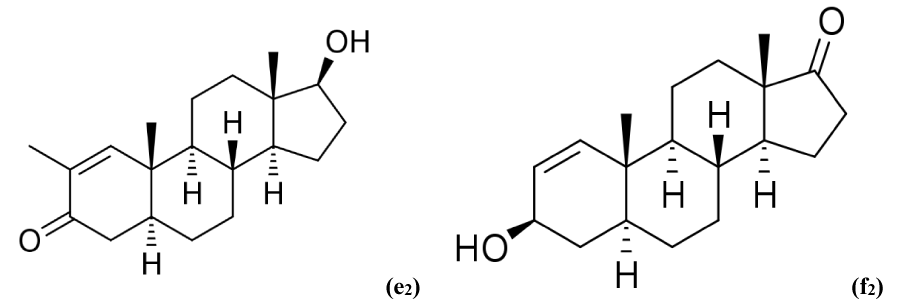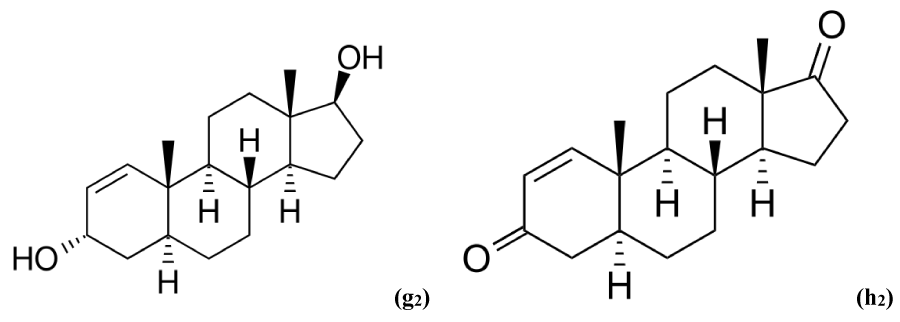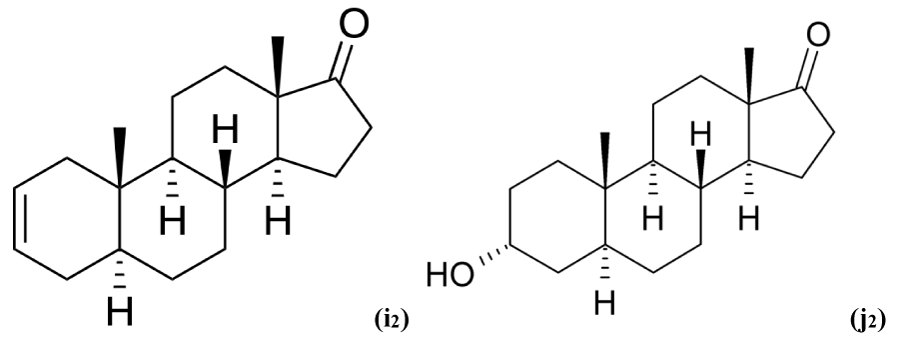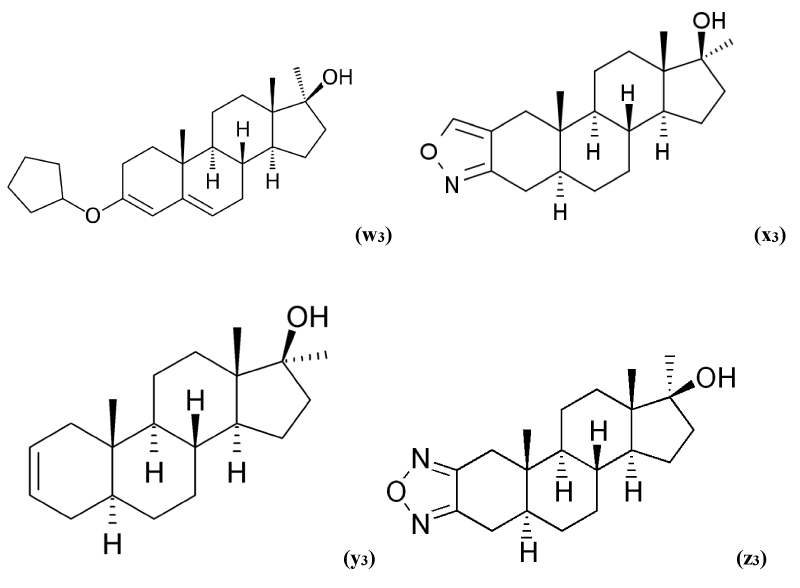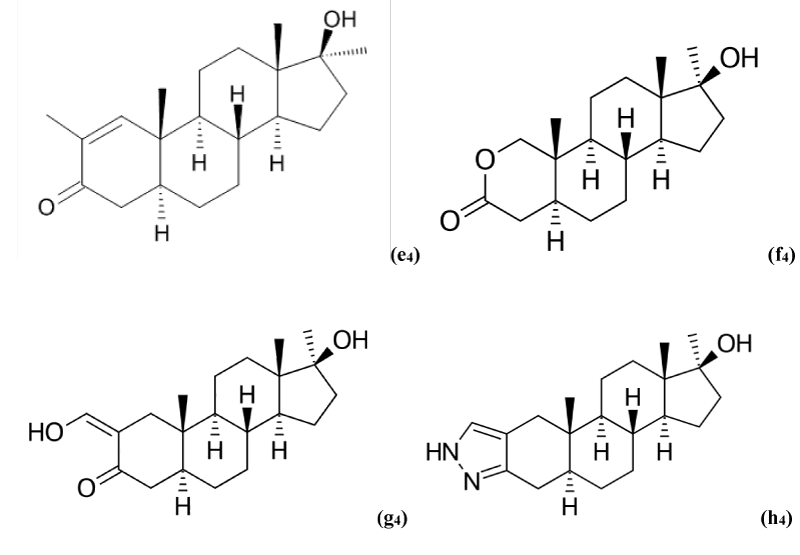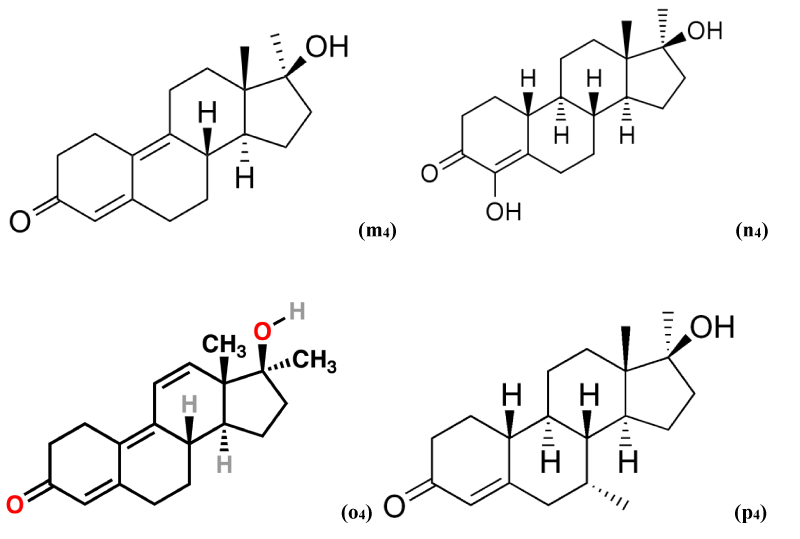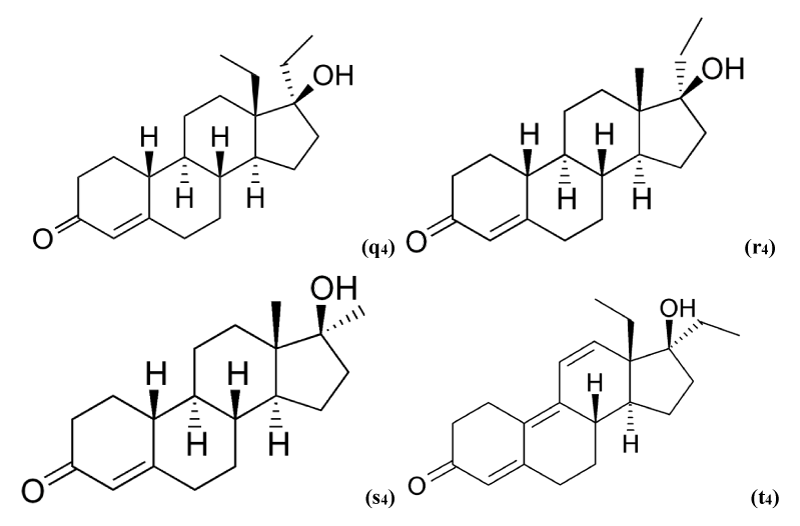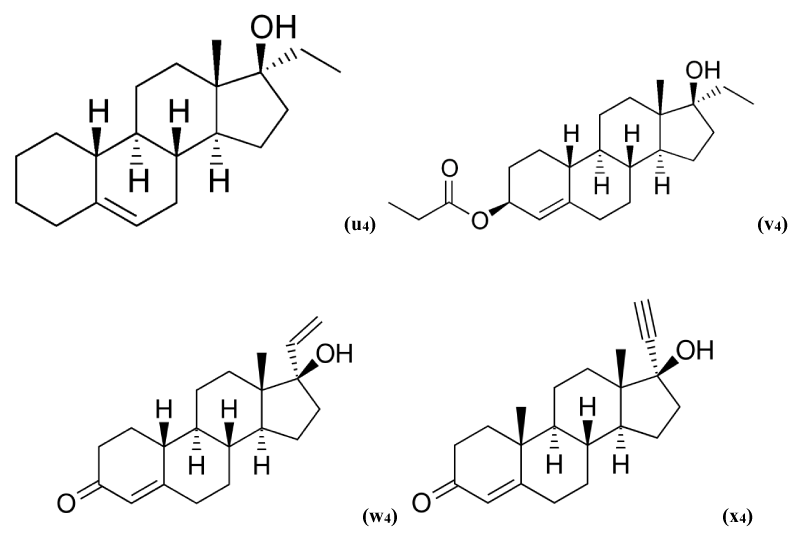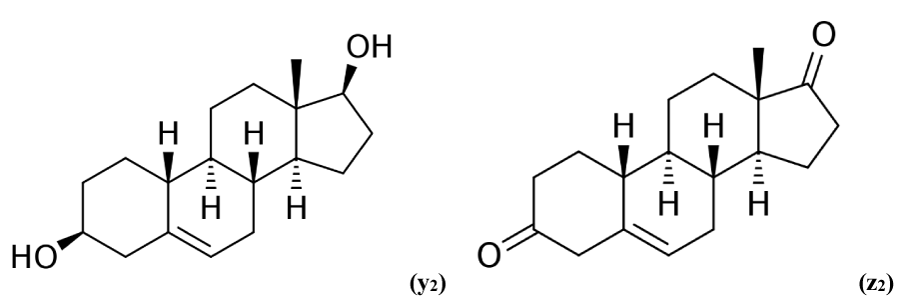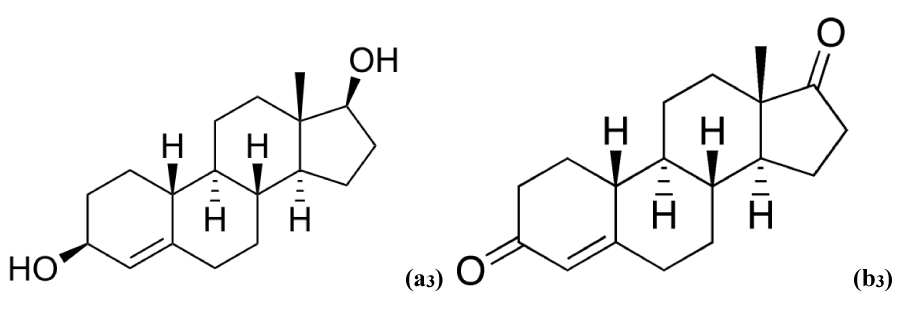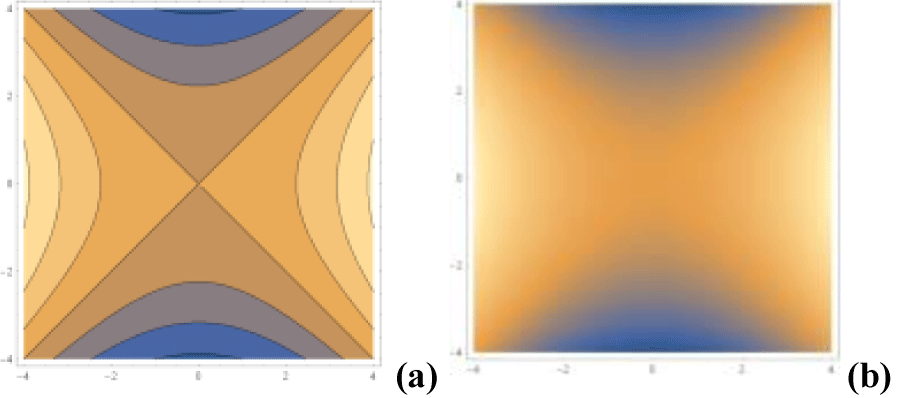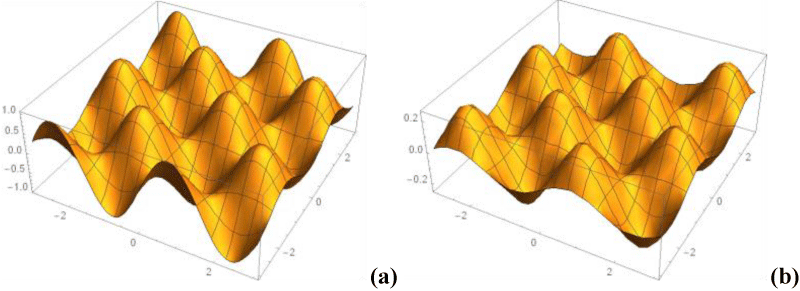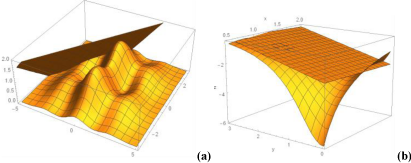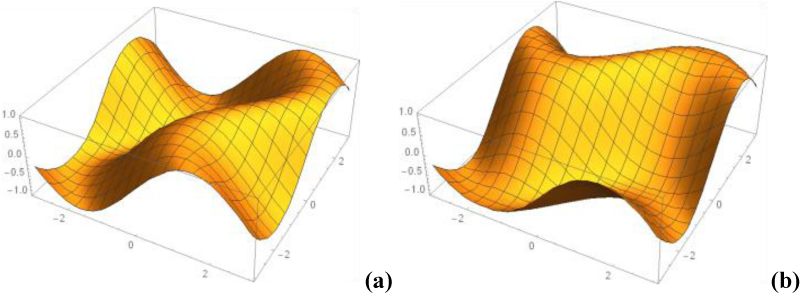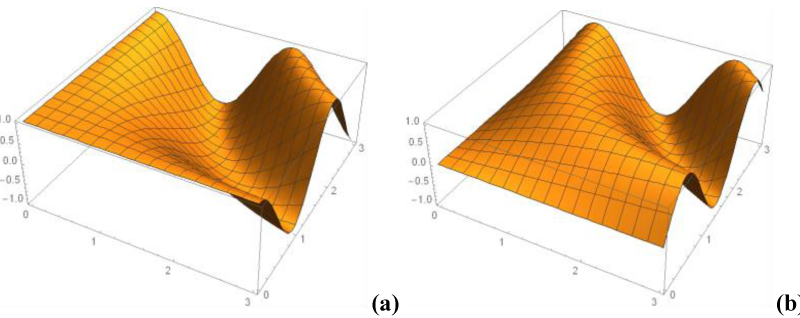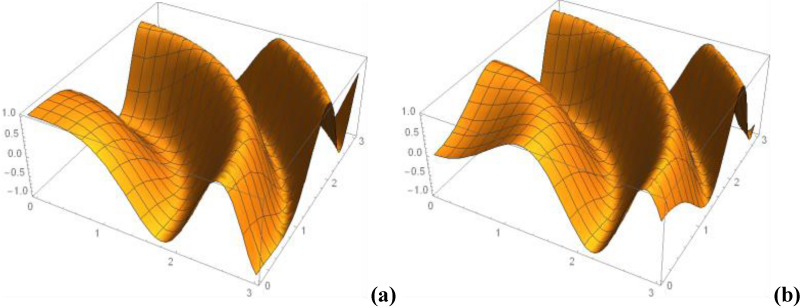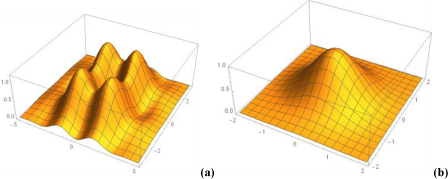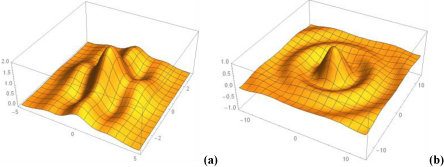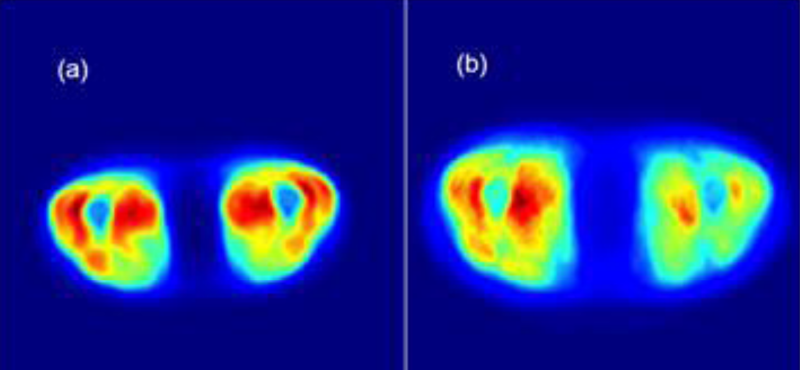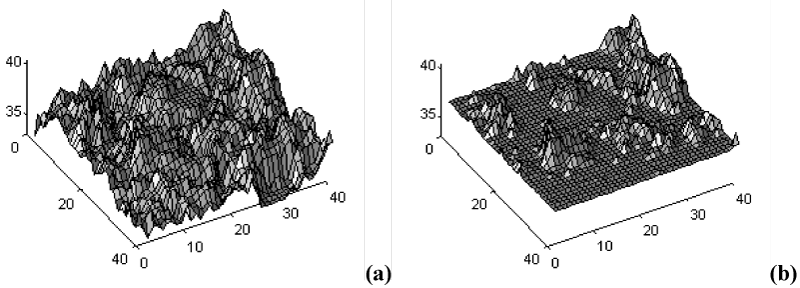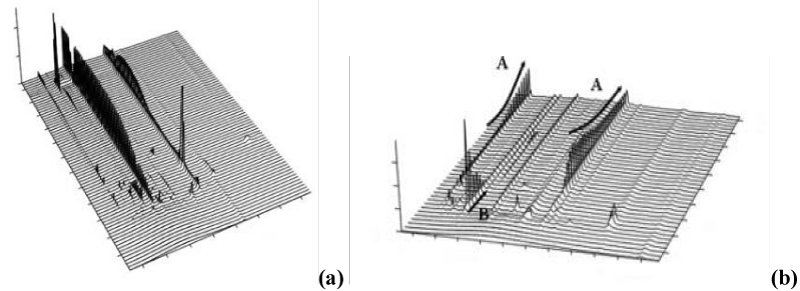Research Article
Pros and Cons Controversy on Molecular Imaging and Dynamics of Double-Standard DNA/RNA of Human Preserving Stem Cells-Binding Nano Molecules with Androgens/Anabolic Steroids (AAS) or Testosterone Derivatives through Tracking of Helium-4 Nucleus (Alpha Particle) Using Synchrotron Radiation

Alireza Heidari*
Faculty of Chemistry, California South University, 14731 Comet St. Irvine, CA 92604, USA*Address for Correspondence: Dr. Alireza Heidari, Faculty of Chemistry, California South University, 14731 Comet St. Irvine, CA 92604, USA, Email: [email protected]; [email protected]
Dates: Submitted: 31 October 2017; Approved: 13 November 2017; Published: 15 November 2017
How to cite this article: Heidari A. Pros and Cons Controversy on Molecular Imaging and Dynamics of Double-Standard DNA/RNA of Human Preserving Stem Cells-Binding Nano Molecules with Androgens/Anabolic Steroids (AAS) or Testosterone Derivatives through Tracking of Helium-4 Nucleus (Alpha Particle) Using Synchrotron Radiation. Arch Biotechnol Biomed. 2017; 1: 067-100. DOI: 10.29328/journal.abb.1001007
Copyright License: © 2017 Heidari A. This is an open access article distributed under the Creative Commons Attribution License, which permits unrestricted use, distribution, and reproduction in any medium, provided the original work is properly cited.
Keywords: Molecular Imaging; Molecular Dynamics; Double-Standard DNA/RNA; Stem Cells; Binding; Nano Molecules; Androgens/Anabolic Steroids (AAS); Testosterone Derivatives; Helium-4 Nucleus; Alpha Particle; Synchrotron Radiation; Nucleic Acids
Abstract
Introduction
The enzymatic oxidation of double-standard DNA/RNA of human preserving stem cells-binding Nano molecules by haem peroxidases (or heme peroxidases) such as Horseradish Peroxidase (HPR), Chloroperoxidase (CPO), Lactoperoxidase (LPO) and Lignin Peroxidase (LiP) is an important process from both the synthetic and mechanistic point of view [1-100]. Currently, molecular imaging and dynamics of double-standard DNA/RNA of human preserving stem cells-binding Nano molecules with Androgens/Anabolic Steroids (AAS) (Figure 1) or Testosterone derivatives (Figure 2) such as Testosterone [Androst-4-en-17β-ol-3-one], 4-Hydroxytestosterone [4-Hydroxytestosterone], 11-Ketotestosterone [11-Ketotestosterone], Boldenone [Δ1-Testosterone], Clostebol [4-Chlorotestosterone], 4-Androstenediol [4-Androstenediol], 4-Dehydroepiandrosterone (4-DHEA) [4-Dehydroepiandrosterone], 5-Androstenedione [5-Androstenedione], 5-Dehydroandrosterone (5-DHA) [5-Dehydroandrosterone], 11β-Hydroxyandrostenedione (11β-OHA4) [11β-Hydroxy-4-androstenedione], Adrenosterone (11-ketoandrostenedione, 11-KA4) [11-Keto-4-androstenedione], Androstenediol (5-androstenediol, A5) [5-Androstenediol], Androstenedione (4-androstenedione, A4) [4-Androstenedione], Atamestane [1-Methyl-δ1-4-androstenedione], Boldione (1,4-androstadienedione) [δ1-4-Androstenedione], Dehydroepiandrosterone (DHEA, 5-DHEA; prasterone, androstenolone) [5-Dehydroepiandrosterone], Exemestane [6-Methylidene-δ1-4-androstenedione], Formestane [4-Hydroxy-4-androstenedione], Plomestane [10-Propargyl-4-androstenedione], Cloxotestosterone [Testosterone 17-chloral hemiacetal ether], Quinbolone [Δ1-Testosterone 17β-cyclopentenyl enol ether], Silandrone [Testosterone 17β-trimethylsilyl ether], Dihydrotestosterone (DHT; androstanolone, stanolone) [4,5α-Dihydrotestosterone], 1-Testosterone (dihydro-1-testosterone, dihydroboldenone) [4,5α-Dihydro-δ1-testosterone], 11-Ketodihydrotestosterone (11-KDHT) [11-Keto-4,5α-dihydrotestosterone], Drostanolone [2α-Methyl-4,5α-dihydrotestosterone], Epitiostanol (epithioandrostanol) [2α,3α-Epithio-3-deketo-4,5α-dihydrotestosterone], Mesterolone [1α-Methyl-4,5α-dihydrotestosterone], Metenolone (methenolone, methylandrostenolone) [1-Methyl-4,5α-dihydro-δ1-testosterone], Nisterime [2α-Chloro-4,5α-dihydrotestosterone O-(p-nitrophenyl)oxime], Stenbolone [2-Methyl-4,5α-dihydro-δ1-testosterone], 1-Androsterone (1-Andro, 1-DHEA) [1-Dehydroepiandrosterone], 1-Androstenediol (dihydro-1-androstenediol) [1-Androstenediol (4,5α-dihydro-δ1-4-androstenediol)], 1-Androstenedione (dihydro-1-androstenedione) [1-Androstenedione (4,5α-dihydro-δ1-4-androstenedione)], 5α-Androst-2-en-17-one [3-Deketo-2-androstenedione (3-deketo-4,5α-dihydro-δ2-4-androstenedione)], Androsterone [Androsterone], Epiandrosterone [Epiandrosterone], Mepitiostane [2α,3α-Epithio-3-deketo-4,5α-dihydrotestosterone 17β-(1-methoxycyclopentane) ether], Mesabolone [4,5α-Dihydro-δ1-testosterone 17β-(1-methoxycyclohexane) ether], Prostanozol [2,3-4(4’,3’-Pyrazol)-3-deketo-4,5α-dihydrotestosterone 17β-tetrahydropyran ether], Bolazine (di(drostanolone) azine) [3,3-[(1E,2E)-1,2-Hydrazinediylidene]di(2α-methyl-5α-androstan-17β-ol)], Nandrolone (nortestosterone) [19-Nortestosterone], 11β-Methyl-19-nortestosterone (11β-MNT) [11β-Methyl-19-nortestosterone], Dienolone [19-Nor-δ9-testosterone], Dimethandrolone [7α,11β-Dimethyl-19-nortestosterone], Norclostebol [4-Chloro-19-nortestosterone], Oxabolone [4-Hydroxy-19-nortestosterone], Trenbolone (trienolone) [19-Nor-δ9,11-testosterone], Trestolone (MENT) [7α-Methyl-19-nortestosterone], 7α-Methyl-19-nor-4-androstenedione (MENT dione, trestione) [7α-Methyl-19-nor-4-androstenedione], 19-Nor-5-androstenediol [19-Nor-5-androstenediol], 19-Nor-5-androstenedione [19-Nor-5-androstenedione], Bolandiol (nor-4-androstenediol) [19-Nor-4-androstenediol], Bolandione (nor-4-androstenedione) [19-Nor-4-androstenedione], Dienedione (nor-4,9-androstadienedione) [19-Nor-δ9-4-androstenedione], Methoxydienone (methoxygonadiene) [18-Methyl-19-nor-δ2,5(10)-epiandrosterone 3-methyl ether], Bolmantalate (nandrolone adamantoate) [19-Nortestosterone 17β-adamantoate], Bolasterone [7α,17α-Dimethyltestosterone], Calusterone [7β,17α-Dimethyltestosterone], Chlorodehydromethyltestosterone (CDMT) [4-Chloro-17α-methyl-δ1-testosterone], Enestebol [4-Hydroxy-17α-methyl-δ1-testosterone], Ethyltestosterone [17α-Ethyltestosterone], Fluoxymesterone [9α-Fluoro-11β-hydroxy-17α-methyltestosterone], Formebolone [2-Formyl-11α-hydroxy-17α-methyl-δ1-testosterone], Hydroxystenozole [?,?(?,?-Pyrazol)-3-deketo-δ2-testosterone], Metandienone (methandienone, methandrostenolone) [17α-Methyl-δ1-testosterone], Methylclostebol (chloromethyltestosterone) [4-Chloro-17α-methyltestosterone], Methyltestosterone [17α-Methyltestosterone], Oxymesterone [4-Hydroxy-17α-methyltestosterone], Tiomesterone (thiomesterone) [1α,7α-Diacetylthio-17α-methyltestosterone], Chlorodehydromethylandrostenediol (CDMA) [4-Chloro-17α-methyl-δ1-4-androstenediol], Chloromethylandrostenediol (CMA) [4-Chloro-17α-methyl-4-androstenediol], Methandriol (methylandrostenediol) [17α-Methyl-5-androstenediol], Methyltestosterone 3-hexyl ether [17α-Methyl-4-hydro-δ3,5-testosterone 3-hexyl ether], Penmesterol (penmestrol) [17α-Methyl-4-hydro-δ3,5-testosterone 3-cyclopentyl ether], Androisoxazole [2,3-Isoxazol-3-deketo-17α-methyl-4,5α-dihydrotestosterone], Desoxymethyltestosterone [3-Deketo-17α-methyl-4,5α-dihydro-δ2-testosterone], Furazabol [2,3-Furazan-3-deketo-17α-methyl-4,5α-dihydrotestosterone], Mestanolone (methyl-DHT) [17α-Methyl-4,5α-dihydrotestosterone], Methasterone (methyldrostanolone) [2α,17α-Dimethyl-4,5α-dihydrotestosterone], Methyl-1-testosterone (methyldihydro-1-testosterone) [17α-Methyl-4,5α-dihydro-δ1-testosterone], Methylepitiostanol [2α,3α-Epithio-3-deketo-17α-methyl-4,5α-dihydrotestosterone], Methylstenbolone [2,17α-Dimethyl-4,5α-dihydro-δ1-testosterone], Oxandrolone [2-Oxa-17α-methyl-4,5α-dihydrotestosterone], Oxymetholone [2-Hydroxymethylene-4,5α-dihydro-17α-methyltestosterone], Stanozolol [2,3-4(4’,3’-Pyrazol)-3-deketo-17α-methyl-4,5α-dihydrotestosterone], Mebolazine (dimethazine, di(methasterone) azine) [3,3-[(1E,2E)-1,2-Hydrazinediylidene]di(2α,17α-dimethyl-5α-androstan-17β-ol)], Dimethyltrienolone (7α,17α-dimethyltrenbolone) [7α,17α-Dimethyl-19-nor-δ9,11-testosterone], Ethyldienolone [17α-Ethyl-19-nor-δ9-testosterone], Ethylestrenol (ethylnandrol) [17α-Ethyl-3-deketo-19-nortestosterone], Methyldienolone [17α-Methyl-19-nor-δ9-testosterone], Methylhydroxynandrolone (MOHN, MHN) [4-Hydroxy-17α-methyl-19-nortestosterone], Metribolone (methyltrienolone, R-1881) [17α-Methyl-19-nor-δ9,11-testosterone], Mibolerone [7α,17α-Dimethyl-19-nortestosterone], Norboletone [17α-Ethyl-18-methyl-19-nortestosterone], Norethandrolone (ethylnandrolone, ethylestrenolone) [17α-Ethyl-19-nortestosterone], Normethandrone (methylestrenolone, normethisterone) [17α-Methyl-19-nortestosterone], Tetrahydrogestrinone (THG) [17α-Ethyl-18-methyl-19-nor-δ9,11-testosterone], Bolenol (ethylnorandrostenol) [3-Deketo-17α-ethyl-19-nor-5-androstenediol], Propetandrol [17α-Ethyl-19-nortestosterone 3-propionate], Vinyltestosterone [17α-Ethenyltestosterone], Norvinisterone (vinylnortestosterone) [17α-Ethenyltestosterone], Ethisterone (ethinyltestosterone) [17α-Ethynyltestosterone], Danazol (2,3-isoxazolethisterone) [2,3-Isoxazol-17α-ethynyltestosterone], Norethisterone (norethindrone) [17α-Ethynyl-19-nortestosterone], Etynodiol (ethynodiol, 3β-hydroxynorethisterone) [17α-Ethynyl-3-deketo-3β-hydroxy-19-nortestosterone], Gestrinone (ethylnorgestrienone, R-2323) [17α-Ethynyl-18-methyl-19-nor-δ9,11-testosterone], Levonorgestrel ((−)-norgestrel) [(−)-17α-Ethynyl-18-methyl-19-nortestosterone], Lynestrenol (3-deketonorethisterone) [17α-Ethynyl-3-deketo-19-nortestosterone], Norgestrel (18-methylnorethisterone) [17α-Ethynyl-18-methyl-19-nortestosterone], Norgestrienone (ethynyltrenbolone) [17α-Ethynyl-19-nor-δ9,11-testosterone], Tibolone (7α-methylnoretynodrel) [7α-Methyl-17α-ethynyl-19-nor-δ5(10)-testosterone], Quingestanol [4-Hydro-19-nor-δ3,5-testosterone 3-cyclopentyl ether], Etynodiol diacetate (ethynodiol diacetate) [17α-Ethynyl-3-deketo-3β-hydroxy-19-nortestosterone 3β,17β-diacetate], Norethisterone acetate (norethindrone acetate) [17α-Ethynyl-19-nortestosterone 17β-acetate], Norethisterone enanthate (norethindrone enanthate) [17α-Ethynyl-19-nortestosterone 17β-enanthate] and Quingestanol acetate [4-Hydro-17α-ethynyl-19-nor-δ3,5-testosterone 3-cyclopentyl ether 17β-acetate] (Figure 3), is receiving considerable interests [101-297]. In the current study, we have investigated pros and cons controversy on molecular imaging and dynamics of double-standard DNA/RNA of human preserving stem cells-binding Nano molecules with Androgens/Anabolic Steroids (AAS) or Testosterone derivatives through tracking of Helium-4 nucleus (Alpha particle) using synchrotron radiation.
Figure 3: Molecular structure of Testosterone derivatives: (a1) 4-Hydroxytestosterone [4-Hydroxytestosterone], (b1) 11-Ketotestosterone [11-Ketotestosterone], (c1) Boldenone [Δ1-Testosterone], (d1) Clostebol [4-Chlorotestosterone].
Figure 3: (e1) 4-Androstenediol [4-Androstenediol], (f1) 4-Dehydroepiandrosterone (4-DHEA), [4-Dehydroepiandrosterone], (g1) 5-Androstenedione [5-Androstenedione], (h1) 5-Dehydroandrosterone (5-DHA) [5-Dehydroandrosterone]. (i1) 11β-Hydroxyandrostenedione (11β-OHA4) [11β-Hydroxy-4-androstenedione], (j1) Adrenosterone (11-ketoandrostenedione, 11-KA4) [11-Keto-4-androstenedione].
Figure 3: (k1) Androstenediol (5-androstenediol, A5) [5-Androstenediol], (l1) Androstenedione (4-androstenedione, A4) [4-Androstenedione], (m1) Atamestane [1-Methyl-δ1-4-androstenedione], (n1) Boldione (1,4-androstadienedione) [δ1-4-Androstenedione].
Figure 3: (o1) Dehydroepiandrosterone (DHEA, 5-DHEA; prasterone, androstenolone) [5-Dehydroepiandrosterone], (p1) Exemestane [6-Methylidene-δ1-4-androstenedione], (q1) Formestane [4-Hydroxy-4-androstenedione], (r1) Plomestane [10-Propargyl-4-androstenedione].
Figure 3: (s1) Cloxotestosterone [Testosterone 17-chloral hemiacetal ether], (t1) Quinbolone [Δ1-Testosterone 17β-cyclopentenyl enol ether], (u1) Silandrone [Testosterone 17β-trimethylsilyl ether], (v1) Dihydrotestosterone (DHT; androstanolone, stanolone) [4,5α-Dihydrotestosterone].
Figure 3: (w1) 1-Testosterone (dihydro-1-testosterone, dihydroboldenone) [4,5α-Dihydro-δ1-testosterone], (x1) 11-Ketodihydrotestosterone (11-KDHT) [11-Keto-4,5α-dihydrotestosterone], (y1) Drostanolone [2α-Methyl-4,5α-dihydrotestosterone], (z1) Epitiostanol (epithioandrostanol) [2α,3α-Epithio-3-deketo-4,5α-dihydrotestosterone].
Figure 3: (a2) Mesterolone [1α-Methyl-4,5α-dihydrotestosterone], (b2) Metenolone (methenolone, methylandrostenolone) [1-Methyl-4,5α-dihydro-δ1-testosterone], (c2) Nisterime [2α-Chloro-4,5α-dihydrotestosterone O-(p-nitrophenyl)oxime], (d2) Stenbolone [2-Methyl-4,5α-dihydro-δ1-testosterone].
Figure 3: (e2) 1-Androsterone (1-Andro, 1-DHEA) [1-Dehydroepiandrosterone], (f2) 1-Androstenediol (dihydro-1-androstenediol) [1-Androstenediol (4,5α-dihydro-δ1-4-androstenediol)], (g2) 1-Androstenedione (dihydro-1-androstenedione) [1-Androstenedione (4,5α-dihydro-δ1-4-androstenedione)], (h2) 5α-Androst-2-en-17-one [3-Deketo-2-androstenedione (3-deketo-4,5α-dihydro-δ2-4-androstenedione)].
Figure 3: (i2) Androsterone [Androsterone], (j2) Epiandrosterone [Epiandrosterone], (k2) Mepitiostane [2α,3α-Epithio-3-deketo-4,5α-dihydrotestosterone 17β-(1-methoxycyclopentane) ether], (l2) Mesabolone [4,5α-Dihydro-δ1-testosterone 17β-(1-methoxycyclohexane) ether].
Figure 3: (m2) Prostanozol [2,3-4(4’,3’-Pyrazol)-3-deketo-4,5α-dihydrotestosterone 17β-tetrahydropyran ether], (n2) Bolazine (di(drostanolone) azine) [3,3-[(1E,2E)-1,2-Hydrazinediylidene]di(2α-methyl-5α-androstan-17β-ol)], (o2) Nandrolone (nortestosterone) [19-Nortestosterone], (p2) 11β-Methyl-19-nortestosterone (11β-MNT) [11β-Methyl-19-nortestosterone].
Figure 3: (q2) Dienolone [19-Nor-δ9-testosterone], (r2) Dimethandrolone [7α,11β-Dimethyl-19-nortestosterone], (s2) Norclostebol [4-Chloro-19-nortestosterone], (t2) Oxabolone [4-Hydroxy-19-nortestosterone].
Figure 3: (u2) Trenbolone (trienolone) [19-Nor-δ9,11-testosterone], (v2) Trestolone (MENT) [7α-Methyl-19-nortestosterone], (w2) 7α-Methyl-19-nor-4-androstenedione (MENT dione, trestione) [7α-Methyl-19-nor-4-androstenedione], (x2) 19-Nor-5-androstenediol [19-Nor-5-androstenediol].
Figure 3: (y2) 19-Nor-5-androstenedione [19-Nor-5-androstenedione], (z2) Bolandiol (nor-4-androstenediol) [19-Nor-4-androstenediol], (a3) Bolandione (nor-4-androstenedione) [19-Nor-4-androstenedione], (b3) Dienedione (nor-4,9-androstadienedione) [19-Nor-δ9-4-androstenedione].
Figure 3: (c3) Methoxydienone (methoxygonadiene) [18-Methyl-19-nor-δ2,5(10)-epiandrosterone 3-methyl ether], (d3) Bolmantalate (nandrolone adamantoate) [19-Nortestosterone 17β-adamantoate], (e3) Bolasterone [7α,17α-Dimethyltestosterone], (f3) Calusterone [7β,17α-Dimethyltestosterone].
Figure 3: (g3) Chlorodehydromethyltestosterone (CDMT) [4-Chloro-17α-methyl-δ1-testosterone], (h3) Enestebol [4-Hydroxy-17α-methyl-δ1-testosterone], (i3) Ethyltestosterone [17α-Ethyltestosterone], (j3) Fluoxymesterone [9α-Fluoro-11β-hydroxy-17α-methyltestosterone].
Figure 3: (k3) Formebolone [2-Formyl-11α-hydroxy-17α-methyl-δ1-testosterone], (l3) Hydroxystenozole [?,?(?,?-Pyrazol)-3-deketo-δ2-testosterone], (m3) Metandienone (methandienone, methandrostenolone) [17α-Methyl-δ1-testosterone], (n3) Methylclostebol (chloromethyltestosterone) [4-Chloro-17α-methyltestosterone].
Figure 3: (o3) Methyltestosterone [17α-Methyltestosterone], (p3) Oxymesterone [4-Hydroxy-17α-methyltestosterone], (q3) Tiomesterone (thiomesterone) [1α,7α-Diacetylthio-17α-methyltestosterone], (r3) Chlorodehydromethylandrostenediol (CDMA) [4-Chloro-17α-methyl-δ1-4-androstenediol].
Figure 3: (s3) Chloromethylandrostenediol (CMA) [4-Chloro-17α-methyl-4-androstenediol], (t3) Methandriol (methylandrostenediol) [17α-Methyl-5-androstenediol], (u3) Methyltestosterone 3-hexyl ether [17α-Methyl-4-hydro-δ3,5-testosterone 3-hexyl ether], (v3) Penmesterol (penmestrol) [17α-Methyl-4-hydro-δ3,5-testosterone 3-cyclopentyl ether].
Figure 3: (w3) Androisoxazole [2,3-Isoxazol-3-deketo-17α-methyl-4,5α-dihydrotestosterone], (x3) Desoxymethyltestosterone [3-Deketo-17α-methyl-4,5α-dihydro-δ2-testosterone], (y3) Furazabol [2,3-Furazan-3-deketo-17α-methyl-4,5α-dihydrotestosterone], (z3) Mestanolone (methyl-DHT) [17α-Methyl-4,5α-dihydrotestosterone].
Figure 3: (a4) Methasterone (methyldrostanolone) [2α,17α-Dimethyl-4,5α-dihydrotestosterone], (b4) Methyl-1-testosterone (methyldihydro-1-testosterone) [17α-Methyl-4,5α-dihydro-δ1-testosterone], (c4) Methylepitiostanol [2α,3α-Epithio-3-deketo-17α-methyl-4,5α-dihydrotestosterone], (d4) Methylstenbolone [2,17α-Dimethyl-4,5α-dihydro-δ1-testosterone].
Figure 3: (e4) Oxandrolone [2-Oxa-17α-methyl-4,5α-dihydrotestosterone], (f4) Oxymetholone [2-Hydroxymethylene-4,5α-dihydro-17α-methyltestosterone], (g4) Stanozolol [2,3-4(4’,3’-Pyrazol)-3-deketo-17α-methyl-4,5α-dihydrotestosterone], (h4) Mebolazine (dimethazine, di(methasterone) azine) [3,3-[(1E,2E)-1,2-Hydrazinediylidene]di(2α,17α-dimethyl-5α-androstan-17β-ol)].
Figure 3: (i4) Dimethyltrienolone (7α,17α-dimethyltrenbolone) [7α,17α-Dimethyl-19-nor-δ9,11-testosterone], (j4) Ethyldienolone [17α-Ethyl-19-nor-δ9-testosterone], (k4) Ethylestrenol (ethylnandrol) [17α-Ethyl-3-deketo-19-nortestosterone], (l4) Methyldienolone [17α-Methyl-19-nor-δ9-testosterone].
Figure 3: (m4) Methylhydroxynandrolone (MOHN, MHN) [4-Hydroxy-17α-methyl-19-nortestosterone], (n4) Metribolone (methyltrienolone, R-1881) [17α-Methyl-19-nor-δ9,11-testosterone], (o4) Mibolerone [7α,17α-Dimethyl-19-nortestosterone], (p4) Norboletone [17α-Ethyl-18-methyl-19-nortestosterone].
Figure 3: (q4) Norethandrolone (ethylnandrolone, ethylestrenolone) [17α-Ethyl-19-nortestosterone], (r4) Normethandrone (methylestrenolone, normethisterone) [17α-Methyl-19-nortestosterone], (s4) Tetrahydrogestrinone (THG) [17α-Ethyl-18-methyl-19-nor-δ9,11-testosterone], (t4) Bolenol (ethylnorandrostenol) [3-Deketo-17α-ethyl-19-nor-5-androstenediol].
Figure 3: (u4) Propetandrol [17α-Ethyl-19-nortestosterone 3-propionate], (v4) Vinyltestosterone [17α-Ethenyltestosterone], (w4) Norvinisterone (vinylnortestosterone) [17α-Ethenyltestosterone], (x4) Ethisterone (ethinyltestosterone) [17α-Ethynyltestosterone].
Figure 3: (y4) Danazol (2,3-isoxazolethisterone) [2,3-Isoxazol-17α-ethynyltestosterone], (z4) Norethisterone (norethindrone) [17α-Ethynyl-19-nortestosterone], (a5) Etynodiol (ethynodiol, 3β-hydroxynorethisterone) [17α-Ethynyl-3-deketo-3β-hydroxy-19-nortestosterone], (b5) Gestrinone (ethylnorgestrienone, R-2323) [17α-Ethynyl-18-methyl-19-nor-δ9,11-testosterone].
Figure 3: (c5) Levonorgestrel ((−)-norgestrel) [ (−)-17α-Ethynyl-18-methyl-19-nortestosterone], (d5) Lynestrenol (3-deketonorethisterone) [17α-Ethynyl-3-deketo-19-nortestosterone], (e5) Norgestrel (18-methylnorethisterone) [17α-Ethynyl-18-methyl-19-nortestosterone], (f5) Norgestrienone (ethynyltrenbolone) [17α-Ethynyl-19-nor-δ9,11-testosterone].
Figure 3: (g5) Tibolone (7α-methylnoretynodrel) [7α-Methyl-17α-ethynyl-19-nor-δ5(10)-testosterone], (h5) Quingestanol [4-Hydro-19-nor-δ3,5-testosterone 3-cyclopentyl ether], (i5) Etynodiol diacetate (ethynodiol diacetate) [17α-Ethynyl-3-deketo-3β-hydroxy-19-nortestosterone 3β,17β-diacetate], (j5) Norethisterone acetate (norethindrone acetate) [17α-Ethynyl-19-nortestosterone 17β-acetate], (k5) Norethisterone enanthate (norethindrone enanthate) [17α-Ethynyl-19-nortestosterone 17β-enanthate] and (l5) Quingestanol acetate [4-Hydro-17α-ethynyl-19-nor-δ3,5-testosterone 3-cyclopentyl ether 17β-acetate] [1-297].
It should be noted that we have used different light sources as sunchrotron radiation in the current study which include:
Electric discharge such as Electric arc, Arc lamp, Flashtube, Electrostatic discharge, Lightning, Electric spark, Gas discharge lamp, Electrodeless lamp, Excimer lamp, Fluorescent lamp, Compact fluorescent lamp, Tanning lamp, Black lights, Geissler tube, Moore tube, Ruhmkorff lamp, High-intensity discharge lamp, Carbon arc lamp, Ceramic discharge metal-halide lamp, Hydrargyrum medium-arc iodide lamp, Mercury-vapor lamp, Metal-halide lamp, Sodium-vapor lamp, Sulfur lamp, Xenon arc lamp, Hollow-cathode lamp, Induction lighting, Sulfur lamp, Neon and argon lamps, Dekatron, Nixie tube, Plasma lamp and Xenon flash lamp. Incandescence such as Black-body radiation, Carbon button lamp, Earthquake light, Halogen lamp, Incandescent light bulb, Lava, Nernst lamp, Volcanic eruption, Combustion, Argand lamp, Argon flash, Carbide lamp, Betty lamp, Butter lamp, Flash-lamp, Gas lighting, Gas mantle, Kerosene lamps, Lanterns, Limelights, Oil lamps, Tilley lamp, Bunsen burner, Candle, Embers, Explosives, Fire, Fire whirl, Fireworks, Flamethrower, Muzzle flash, Rubens’ tube, Torch, Nuclear and high-energy particle and Annihilation. Celestial and atmospheric such as Astronomical objects, Sun (sunlight, solar radiation), Corona, Photosphere, Stars (Starlight), Nova/supernova/hypernova, Galaxies, Milky Way, Star clusters, Deep sky objects, Quasars, Accretion discs, Blazars, Magnetars, Pulsars, Atmospheric entry, Meteors, Meteor showers, Bolide, Earth-grazing fireball, Lightning (Plasma), Sprite (lightning), Ball lightning, Upper-atmospheric lightning, Dry lightning, Aurorae, Čerenkov radiation, Luminescence, Chemiluminescence, Bioluminescence, Aequorea Victoria, Antarctic krill, Cavitation bubbles, Foxfire, Glowworm, Luciferase, Panellus stipticus, Parchment worm, Piddock, Electrochemiluminescence and Crystalloluminescence. Electroluminescence such as Light-emitting diodes, Organic light-emitting diodes, Polymer light-emitting diodes, AMOLED, Light-emitting electrochemical cell, Electroluminescent wires, Field-induced polymer electroluminescent, Laser, Chemical laser, Dye laser, Free-electron laser, Gas dynamic laser, Gas laser, Ion laser, Laser diode, Metal-vapor laser, Nonlinear optics, Quantum well laser, Ruby laser, Solid-state laser, Cathodoluminescence, Mechanoluminescence, Triboluminescence, Fractoluminescence, Piezoluminescence, Sonoluminescence, Photoluminescence, Fluorescence, Phosphorescence, Radioluminescence, Thermoluminescence, Cryoluminescence, Luminous efficacy and Photometry (optics).
Graphical Figures: Different high-resolution simulations of molecular imaging and dynamics of double-standard DNA/RNA of human preserving stem cells-binding Nano molecules with Androgens/Anabolic Steroids (AAS) or testosterone derivatives through tracking of Helium-4 nucleus (Alpha particle) (a) before and (b) after irradiating of synchrotron radiation in transformation process to benign human cancer cells and tissues using different nanomaterials analysis techniques and methods with the passing of time [1-297].
Materials, research method and experimental techniques
In this study, different types of molecular imaging and dynamics of double-standard DNA/RNA of human preserving stem cells-binding Nano molecules with Androgens/Anabolic Steroids (AAS) or Testosterone derivatives through tracking of Helium-4 nucleus (Alpha particle) under synchrotron radiation by means of Tetrabutylammonium Peroxymonosulfate (TBAO) was performed in the presence of six different phenyl substituted Manganese (III) β-Trifluoromethyl-meso-tetraphenylporphyrins (TPPH2) (Mn-Pors) and imidazole in CH2Cl2 using nanomaterials analysis different methods and techniques such as Analytical Ultracentrifugation, Atomic Absorption Spectroscopy (AAS), Auger Electron Diffraction (AED), Auger Electron Spectroscopy (AES), Atomic Force Microscopy (AFM), Atomic Fluorescence Spectroscopy (AFS ), Atom Probe Field Ion Microscopy (APFIM), Appearance Potential Spectroscopy (APS), Angle Resolved Photoemission Spectroscopy (ARPES), Angle Resolved Ultraviolet Photoemission Spectroscopy (ARUPS), Attenuated Total Reflectance (ATR), BET Surface Area Measurement (BET) (BET from Brunauer, Emmett, Teller), Bimolecular Fluorescence Complementation (BiFC), Backscatter Kikuchi Diffraction (BKD), Bioluminescence Resonance Energy Transfer (BRET), Back Scattered Electron Diffraction (BSED), Coaxial Impact Collision Ion Scattering Spectroscopy (CAICISS), Coherent Anti-Stokes Raman Spectroscopy (CARS), Convergent Beam Electron Diffraction (CBED), Charge Collection Microscopy (CCM), Coherent Diffraction Imaging (CDI), Capillary Electrophoresis (CE), Cryo-Electron Tomography (CET), Cathodoluminescence (CL), Confocal Laser Scanning Microscopy (CLSM), Correlation Spectroscopy (COSY), Cryo-Electron Microscopy (Cryo-EM), Cryo-Scanning Electron Microscopy (Cryo-SEM), Cyclic Voltammetry (CV), Dielectric Thermal Analysis (DE(T)A), De Haas-van Alphen Effect (dHvA), Differential Interference Contrast Microscopy (DIC), Dielectric Spectroscopy (Dielectric spectroscopy), Dynamic Light Scattering (DLS), Deep-Level Transient Spectroscopy (DLTS), Dynamic Mechanical Analysis (DMA), Dual Polarisation Interferometry (DPI), Diffuse Reflection Spectroscopy (DRS), Differential Scanning Calorimetry (DSC), Differential Thermal Analysis (DTA), Dynamic Vapour Sorption (DVS), Electron Beam Induced Current (EBIC), Elastic (Non-Rutherford) Backscattering Spectrometry (EBS), Electron Backscatter Diffraction (EBSD), Exclusive Correlation Spectroscopy (ECOSY), Electrical Capacitance Tomography (ECT), Energy-Dispersive Analysis of X-Rays (EDAX), Electrically Detected Magnetic Resonance (EDMR), Energy Dispersive X-Ray Spectroscopy (EDS or EDX), Electron Energy Loss Spectroscopy (EELS), Energy Filtered Transmission Electron Microscopy (EFTEM), Electron Induced Desorption (EID), Electrical Impedance Tomography and Electrical Resistivity Tomography (EIT and ERT), Electroluminescence (EL), Electron Crystallography, Electrophoretic Light Scattering (ELS), Electron Nuclear Double Resonance (ENDOR), Electron Probe Microanalysis (EPMA), Electron Paramagnetic Resonance Spectroscopy (EPR), Elastic Recoil Detection or Elastic Recoil Detection Analysis (ERD or ERDA), Electron Spectroscopy for Chemical Analysis (ESCA), Electron Stimulated Desorption (ESD), Environmental Scanning Electron Microscopy (ESEM), Electrospray Ionization Mass Spectrometry or Electrospray Mass Spectrometry (ESI-MS or ES-MS), Electron Spin Resonance Spectroscopy (ESR), Electrochemical Scanning Tunneling Microscopy (ESTM), Extended X-Ray Absorption Fine Structure (EXAFS), Exchange Spectroscopy (EXSY), Fluorescence Correlation Spectroscopy (FCS), Fluorescence Cross-Correlation Spectroscopy (FCCS), Field Emission Microscopy (FEM), Focused Ion Beam Microscopy (FIB), Field Ion Microscopy-Atom Probe (FIM-AP), Flow Birefringence, Fluorescence Anisotropy, Fluorescence Lifetime Imaging (FLIM), Fluorescence Microscopy, Feature-Oriented Scanning Probe Microscopy (FOSPM), Fluorescence Resonance Energy Transfer (FRET), Forward Recoil Spectrometry (FRS), Fourier Transform Ion Cyclotron Resonance or Fourier Transform Mass Spectrometry (FTICR or FT-MS), Fourier Transform Infrared Spectroscopy (FTIR), Gas Chromatography-Mass Spectrometry (GC-MS), Glow Discharge Mass Spectrometry (GDMS), Glow Discharge Optical Spectroscopy (GDOS), Grazing Incidence Small Angle X-Ray Scattering (GISAXS), Grazing Incidence X-Ray Diffraction (GIXD), Grazing Incidence X-Ray Reflectivity (GIXR), Gas-Liquid Chromatography (GLC), High Angle Annular Dark-Field Imaging (HAADF), Helium Atom Scattering (HAS), High Performance Liquid Chromatography (HPLC), High Resolution Electron Energy Loss Spectroscopy (HREELS), High-Resolution Electron Microscopy (HREM), High-Resolution Transmission Electron Microscopy (HRTEM), Heavy-Ion Elastic Recoil Detection Analysis (HI-ERDA), High-Energy Proton Induced X-Ray Emission (HE-PIXE), Ion Induced Auger Electron Spectroscopy (IAES), Ion Beam Analysis (IBA), Ion Beam Induced Charge Microscopy (IBIC), Inductively Coupled Plasma Atomic Emission Spectroscopy (ICP-AES), Inductively Coupled Plasma Mass Spectrometry (ICP-MS), Immunofluorescence, Ion Cyclotron Resonance (ICR), Inelastic Electron Tunneling Spectroscopy (IETS), Intelligent Gravimetric Analysis (IGA), Inert Gas Fusion (IGF), Ion Induced X-Ray Analysis (IIX), Ion Neutralization Spectroscopy (INS), Inelastic Neutron Scattering, Infrared Non-Destructive Testing of Materials (IRNDT), Infrared Spectroscopy (IRS), Ion Scattering Spectroscopy (ISS), Isothermal Titration Calorimetry (ITC), Intermediate Voltage Electron Microscopy (IVEM), Low-Angle Laser Light Scattering (LALLS), Liquid Chromatography-Mass Spectrometry (LC-MS), Low-Energy Electron Diffraction (LEED), Low-Energy Electron Microscopy (LEEM), Low-Energy Ion Scattering (LEIS), Laser Induced Breakdown Spectroscopy (LIBS), Laser Optical Emission Spectroscopy (LOES), Light (Raman) Scattering (LS), Matrix-Assisted Laser Desorption/Ionization (MALDI), Molecular Beam Epitaxy (MBE), Medium Energy Ion Scattering (MEIS), Magnetic Force Microscopy (MFM), Magnetic Induction Tomography (MIT), Multiphoton Fluorescence Microscopy (MPM), Magnetic Resonance Force Microscopy (MRFM), Magnetic Resonance Imaging (MRI), Mass Spectrometry (MS), Tandem Mass Spectrometry (MS/MS), Mechanically Stimulated Gas Emission (MSGE), Mössbauer Spectroscopy, Microthermal Analysis (MTA), Neutron Activation Analysis (NAA), Nanovid Microscopy, Neutron Diffraction (ND), Neutron Depth Profiling (NDP), Near Edge X-Ray Absorption Fine Structure (NEXAFS), Nuclear Inelastic Scattering/Absorption (NIS), Nuclear Magnetic Resonance Spectroscopy (NMR), Nuclear Overhauser Effect Spectroscopy (NOESY), Nuclear Reaction Analysis (NRA), Near-Field Optical Microscopy (NSOM), Optical Beam Induced Current (OBIC), Optically Detected Magnetic Resonance (ODNMR), Optical Emission Spectroscopy (OES), Osmometry (Osmometry), Positron Annihilation Spectroscopy (PAS), Photoacoustic Spectroscopy, Photoacoustic Tomography or Photoacoustic Computed Tomography (PAT or PACT), Photoemission of Adsorbed Xenon (PAX), Photocurrent Spectroscopy (PC or PCS), Phase Contrast Microscopy, Photoelectron Diffraction (PhD), Photodesorption (PD), Potentiodynamic Electrochemical Impedance Spectroscopy (PDEIS), Photothermal Deflection Spectroscopy (PDS), Photoelectron Diffraction (PED), Parallel Electron Energy Loss Spectroscopy (PEELS), Photoemission Electron Microscopy or Photoelectron Emission Microscopy (PEEM), Photoelectron Spectroscopy (PES), Photon-Induced Near-Field Electron Microscopy (PINEM), Particle (or Proton) Induced Gamma-Ray Spectroscopy (PIGE), Particle (or Proton) Induced X-Ray Spectroscopy (PIXE), Photoluminescence (PL), Porosimetry, Powder Diffraction, Photothermal Microspectroscopy (PTMS), Photothermal Spectroscopy (PTS), Quasielastic Neutron Scattering (QENS), Raman Spectroscopy (Raman), Resonant Anomalous X-Ray Scattering (RAXRS), Rutherford Backscattering Spectrometry (RBS), Reflection Electron Microscopy (REM), Reflectance Difference Spectroscopy (RDS), Reflection High Energy Electron Diffraction (RHEED), Resonance Ionization Mass Spectrometry (RIMS), Resonant Inelastic X-Ray Scattering (RIXS), Resonance Raman Spectroscopy (RR Spectroscopy), Selected Area Diffraction (SAD), Selected Area Electron Diffraction (SAED), Scanning Auger Microscopy (SAM), Small Angle Neutron Scattering (SANS), Small Angle X-Ray Scattering (SAXS), Surface Composition by Analysis of Neutral Species and Ion-Impact Radiation (SCANIIR), Scanning Confocal Electron Microscopy (SCEM), Spectroscopic Ellipsometry (SE), Size Exclusion Chromatography (SEC), Surface Enhanced Infrared Absorption Spectroscopy (SEIRA), Scanning Electron Microscopy (SEM), Surface Enhanced Raman Spectroscopy (SERS), Surface Enhanced Resonance Raman Spectroscopy (SERRS), Surface Extended X-Ray Absorption Fine Structure (SEXAFS), Scanning Ion-Conductance Microscopy (SICM), Solid Immersion Lens (SIL), Solid Immersion Mirror (SIM), Secondary Ion Mass Spectrometry (SIMS), Sputtered Neutral Species Mass Spectrometry (SNMS), Scanning Near-Field Optical Microscopy (SNOM), Single Photon Emission Computed Tomography (SPECT), Scanning Probe Microscopy (SPM), Selected-Reaction-Monitoring Capillary-Electrophoresis Mass-Spectrometry (SRM-CE/MS), Solid-State Nuclear Magnetic Resonance (SSNMR), Stark Spectroscopy, Stimulated Emission Depletion Microscopy (STED), Scanning Transmission Electron Microscopy (STEM), Scanning Tunneling Microscopy (STM), Scanning Tunneling Spectroscopy (STS), Surface X-Ray Diffraction (SXRD), Thermoacoustic Tomography or Thermoacoustic Computed Tomography (TAT or TACT), Transmission Electron Microscope/Microscopy (TEM), Thermogravimetric Analysis (TGA), Transmitting Ion Kinetic Analysis (TIKA), Thermal Ionization Mass Spectrometry (TIMS), Total Internal Reflection Fluorescence Microscopy (TIRFM), Photothermal Lens Spectroscopy (TLS), Thermomechanical Analysis (TMA), Time-of-Flight Mass Spectrometry (TOF-MS), Two-Photon Excitation Microscopy, Total Reflection X-Ray Fluorescence Analysis (TXRF), Ultrasound Attenuation Spectroscopy, Ultrasonic Testing, UV-Photoelectron Spectroscopy (UPS), Ultra Small-Angle Neutron Scattering (USANS), Ultra Small-Angle X-Ray Scattering (USAXS), Ultraviolet-Visible Spectroscopy (UV-Vis), Video-Enhanced Differential Interference Contrast Microscopy (VEDIC), Voltammetry, Wide Angle X-Ray Scattering (WAXS), Wavelength Dispersive X-Ray Spectroscopy (WDX or WDS), X-Ray Induced Auger Electron Spectroscopy (XAES), Near Edge X-Ray Absorption Fine Structure (XANES or NEXAFS), X-Ray Absorption Spectroscopy (XAS), X-Ray Crystal Truncation Rod Scattering (X-CTR), X-Ray Crystallography, X-Ray Diffuse Scattering (XDS), X-Ray Photoelectron Emission Microscopy (XPEEM), X-Ray Photoelectron Spectroscopy (XPS), X-Ray Diffraction (XRD), X-Ray Resonant Exchange Scattering (XRES), X-Ray Fluorescence Analysis (XRF), X-Ray Reflectivity (XRR), X-Ray Raman Scattering (XRS), X-Ray Standing Wave Technique (XSW) and so on. Furthermore, it should be noted that electron-deficient and bulky substituents on the phenyl groups lowered the catalytic activities of the corresponding Mn-Por and reduce the rate of over oxidation process. Less bulky sulfides with electron-rich Sulfur atoms showed greater reactivity in the oxidation and enhance the selectivity of sulfone products. The investigation of co-catalytic activities of axial Nitrogen donors in the presence of various Mn-Pors indicates the higher co-catalytic activities of weak π-donor pyridines than imidazoles in the presence of electron-deficient catalysts.
Results and Discussion
Development of more environmentally friendly synthetic processes is a rising interest in the chemical community. In addition to its abundance and for economical and safety reasons, Androgens/Anabolic Steroids (AAS) or Testosterone Derivatives has naturally become an alternative as an environmentally benign complex. Moreover, it has been found that reactions with Androgens/Anabolic Steroids (AAS) or Testosterone Derivatives can facilitate access to different reactivity and selectivity patterns compared with those observed with common organic ligands and nucleic acids due to their unique physical and chemical properties.
However, the use of Androgens/Anabolic Steroids (AAS) or Testosterone derivatives in organic reactions has serious limitations. For example, most organic Nano compounds and nucleic acids do not dissolve in Androgens/Anabolic Steroids (AAS) or Testosterone derivatives and many reactive substrates, catalysts, reagents and products are decomposed or deactivated in aqueous media. To overcome these drawbacks in the use of Androgens/Anabolic Steroids (AAS) or Testosterone derivatives as acceptor, surfactants can be used successfully which solubilize organic Nano materials and nucleic acids or form emulsions with them in Testosterone derivatives for consideration and investigation of molecular imaging and dynamics of double-standard DNA/RNA of human preserving stem cells-binding Nano molecules with Androgens/Anabolic Steroids (AAS) or Testosterone derivatives through tracking of Helium-4 nucleus (Alpha particle) under synchrotron radiation.
Conclusions, Perspectives and Future Studies
In the current study, we introduce a green catalytic method for C-C and C-N bond forming via Michael addition of Androgens/Anabolic Steroids (AAS) or Testosterone derivatives to electron-deficient nucleic acids using Zirconium(4+) tetrakis(dodecyl sulfate) [Zr(DS)4] under mild conditions with high yields and selectivity has been developed. The reusability of the catalyst has been successfully examined without any noticeable loss of its catalytic activity using molecular imaging and dynamics of double-standard DNA/RNA of human preserving stem cells-binding Nano molecules with Androgens/Anabolic Steroids (AAS) or Testosterone derivatives through tracking of Helium-4 nucleus (Alpha particle) under synchrotron radiation. Furthermore, we strongly recommend and suggest investigation and study on molecular imaging and dynamics of double-standard DNA/RNA of human preserving stem cells-binding Nano molecules with other Steroids’ types, designer Nano drugs and Androgens through tracking of Helium-4 nucleus (Alpha particle) under synchrotron radiation in the future studies.
References
- Heidari A, Brown C. Study of Composition and Morphology of Cadmium Oxide (CdO) Nanoparticles for Eliminating Cancer Cells. J Nanomedicine Research. 2015; 2: 20.
- Heidari A, Brown C. Study of Surface Morphological, Phytochemical and Structural Characteristics of Rhodium (III) Oxide (Rh2O3) Nanoparticles. Int J Pharmacology, Phytochemistry and Ethnomedicine. 2015; 1: 15-19. Ref.: https://goo.gl/9uVe8Q
- Heidari A. An Experimental Biospectroscopic Study on Seminal Plasma in Determination of Semen Quality for Evaluation of Male Infertility. Int J Adv Technol. 2016; 7: 007. Ref.: https://goo.gl/Ggqz87
- Heidari A. Extraction and Preconcentration of N-Tolyl-Sulfonyl-Phosphoramid-Saeure-Dichlorid as an Anti-Cancer Drug from Plants: A Pharmacognosy Study. J Pharmacogn Nat Prod. 2016; 2: 103.
- Heidari A. A Thermodynamic Study on Hydration and Dehydration of DNA and RNA-Amphiphile Complexes. J Bioeng Biomed Sci S. 2016.
- Heidari A. Computational Studies on Molecular Structures and Carbonyl and Ketene Groups’ Effects of Singlet and Triplet Energies of Azidoketene O=C=CH–NNN and Isocyanatoketene O=C=CH–N=C=O. J Appl Computat Math. 2016; 5: 142.
- Heidari A. Study of Irradiations to Enhance the Induces the Dissociation of Hydrogen Bonds between Peptide Chains and Transition from Helix Structure to Random Coil Structure Using ATR-FTIR, Raman and 1HNMR Spectroscopies. J Biomol Res Ther. 2016; 5: 146.
- Heidari A. Future Prospects of Point Fluorescence Spectroscopy, Fluorescence Imaging and Fluorescence Endoscopy in Photodynamic Therapy (PDT) for Cancer Cells. J Bioanal Biomed. 2016; 8: 135. Ref.: https://goo.gl/XV2pRG
- Heidari A. A Bio-Spectroscopic Study of DNA Density and Color Role as Determining Factor for Absorbed Irradiation in Cancer Cells. Adv Cancer Prev. 2016; 1: 102.
- Heidari A. Manufacturing Process of Solar Cells Using Cadmium Oxide (CdO) and Rhodium (III) Oxide (Rh2O3) Nanoparticles. J Biotechnol Biomater. 2016; 6: 125.
- Heidari A. A Novel Experimental and Computational Approach to Photobiosimulation of Telomeric DNA/RNA: A Biospectroscopic and Photobiological Study. J Res Development. 2016; 4: 144.
- Heidari A. Biochemical and Pharmacodynamical Study of Microporous Molecularly Imprinted Polymer Selective for Vancomycin, Teicoplanin, Oritavancin, Telavancin and Dalbavancin Binding. Biochem Physiol. 2016; 5: 146. Ref.: https://goo.gl/ofpGif
- Heidari A. Anti-Cancer Effect of UV Irradiation at Presence of Cadmium Oxide (CdO) Nanoparticles on DNA of Cancer Cells: A Photodynamic Therapy Study. Arch Cancer Res. 2016; 4: 1.
- Heidari A. Biospectroscopic Study on Multi-Component Reactions (MCRs) in Two A-Type and B-Type Conformations of Nucleic Acids to Determine Ligand Binding Modes, Binding Constant and Stability of Nucleic Acids in Cadmium Oxide (CdO) Nanoparticles-Nucleic Acids Complexes as Anti-Cancer Drugs. Arch Cancer Res. 2016; 4: 2. Ref.: https://goo.gl/dAUNUG
- Heidari A. Simulation of Temperature Distribution of DNA/RNA of Human Cancer Cells Using Time- Dependent Bio-Heat Equation and Nd: YAG Lasers. Arch Cancer Res. 2016; 4: 2. Ref.: https://goo.gl/i9Fyve
- Heidari A. Quantitative Structure-Activity Relationship (QSAR) Approximation for Cadmium Oxide (CdO) and Rhodium (III) Oxide (Rh2O3) Nanoparticles as Anti-Cancer Drugs for the Catalytic Formation of Proviral DNA from Viral RNA Using Multiple Linear and Non-Linear Correlation Approach. Ann Clin Lab Res. 2016; 4: 1.
- Heidari A. Biomedical Study of Cancer Cells DNA Therapy Using Laser Irradiations at Presence of Intelligent Nanoparticles. J Biomedical Sci. 2016; 5: 2. Ref.: https://goo.gl/FMVTfL
- Heidari A. Measurement the Amount of Vitamin D2 (Ergocalciferol), Vitamin D3 (Cholecalciferol) and Absorbable Calcium (Ca2+), Iron (II) (Fe2+), Magnesium (Mg2+), Phosphate (PO4–) and Zinc (Zn2+) in Apricot Using High-Performance Liquid Chromatography (HPLC) and Spectroscopic Techniques. J Biom Biostat. 2016; 7: 292. Ref.: https://goo.gl/6QbvA3
- Heidari A. Spectroscopy and Quantum Mechanics of the Helium Dimer (He2+), Neon Dimer (Ne2+), Argon Dimer (Ar2+), Krypton Dimer (Kr2+), Xenon Dimer (Xe2+), Radon Dimer(Rn2+) and Ununoctium Dimer (Uuo2+) Molecular Cations. Chem Sci J. 2016; 7: 112. Ref.: https://goo.gl/mEuAgH
- Heidari A. Human Toxicity Photodynamic Therapy Studies on DNA/RNA Complexes as a Promising New Sensitizer for the Treatment of Malignant Tumors Using Bio-Spectroscopic Techniques. J Drug Metab Toxicol. 2016; 7: 129. Ref.: https://goo.gl/ffJ6Wm
- Heidari A. Novel and Stable Modifications of Intelligent Cadmium Oxide (CdO) Nanoparticles as Anti- Cancer Drug in Formation of Nucleic Acids Complexes for Human Cancer Cells’ Treatment. Biochem Pharmacol (Los Angel). 2016; 5: 207.
- Heidari A. A Combined Computational and QM/MM Molecular Dynamics Study on Boron Nitride Nanotubes (BNNTs), Amorphous Boron Nitride Nanotubes (A-BNNTs) and Hexagonal Boron Nitride Nanotubes (H-BNNTs) as Hydrogen Storage. Struct Chem Crystallogr Commun. 2016; 2: 1.
- Heidari A. Pharmaceutical and Analytical Chemistry Study of Cadmium Oxide (CdO) Nanoparticles Synthesis Methods and Properties as Anti-Cancer Drug and its Effect on Human Cancer Cells. Pharm Anal Chem Open Access. 2016; 2: 113. Ref.: https://goo.gl/Ax53U6
- Heidari A. A Chemotherapeutic and Biospectroscopic Investigation of the Interaction of Double-Standard DNA/RNA-Binding Molecules with Cadmium Oxide (CdO) and Rhodium (III) Oxide (Rh2O3) Nanoparticles as Anti-Cancer Drugs for Cancer Cells’ Treatment. Chemo Open Access. 2016; 5: 129.
- Heidari A. Pharmacokinetics and Experimental Therapeutic Study of DNA and Other Biomolecules Using Lasers: Advantages and Applications. J Pharmacokinet Exp Ther. 2016; 1: 5.
- Heidari A. Determination of Ratio and Stability Constant of DNA/RNA in Human Cancer Cells and Cadmium Oxide (CdO) Nanoparticles Complexes Using Analytical Electrochemical and Spectroscopic Techniques. Insights Anal Electrochem. 2016; 2: 1.
- Heidari A. Discriminate between Antibacterial and Non-Antibacterial Drugs Artificial Neutral Networks of a Multilayer Perceptron (MLP) Type Using a Set of Topological Descriptors. J Heavy Met Toxicity Dis. 2016; 1: 2.
- Heidari A. Combined Theoretical and Computational Study of the Belousov-Zhabotinsky Chaotic Reaction and Curtius Rearrangement for Synthesis of Mechlorethamine, Cisplatin, Streptozotocin, Cyclophosphamide, Melphalan, Busulphan and BCNU as Anti-Cancer Drugs. Insights Med Phys. 2016; 1: 2. Ref.: https://goo.gl/RXnA8N
- Heidari A. A Translational Biomedical Approach to Structural Arrangement of Amino Acids’ Complexes: A Combined Theoretical and Computational Study. Transl Biomed. 2016; 7: 2. Ref.: https://goo.gl/vhFyrf
- Heidari A. Ab Initio and Density Functional Theory (DFT) Studies of Dynamic NMR Shielding Tensors and Vibrational Frequencies of DNA/RNA and Cadmium Oxide (CdO) Nanoparticles Complexes in Human Cancer Cells. J Nanomedine Biotherapeutic Discov. 2016; 6: 144.
- Heidari A. Molecular Dynamics and Monte-Carlo Simulations for Replacement Sugars in Insulin Resistance, Obesity, LDL Cholesterol, Triglycerides, Metabolic Syndrome, Type 2 Diabetes and Cardiovascular Disease: A Glycobiological Study. J Glycobiol. 2016; 5: 111.
- Heidari A. Synthesis and Study of 5-[(Phenylsulfonyl) Amino]-1,3,4-Thiadiazole-2-Sulfonamide as Potential Anti-Pertussis Drug Using Chromatography and Spectroscopy Techniques. Transl Med (Sunnyvale). 2016; 6: 138.
- Heidari A. Nitrogen, Oxygen, Phosphorus and Sulphur Heterocyclic Anti-Cancer Nano Drugs Separation in the Supercritical Fluid of Ozone (O3) Using Soave-Redlich-Kwong (SRK) and Pang-Robinson (PR) Equations. Electronic J Biol. 2016; 12: 4. Ref.: https://goo.gl/JLY8US
- Heidari A. An Analytical and Computational Infrared Spectroscopic Review of Vibrational Modes in Nucleic Acids. Austin J Anal Pharm Chem. 2016; 3: 1058.
- Heidari A, Brown C. “Phase, Composition and Morphology Study and Analysis of Os-Pd/HfC Nanocomposites. Nano Res Appl. 2016; 2: 1. Ref.: https://goo.gl/Nb53De
- Heidari A, Brown C. Vibrational Spectroscopic Study of Intensities and Shifts of Symmetric Vibration Modes of Ozone Diluted by Cumene. Int J Advanced Chemistry. 2016; 4: 5-9. Ref.: https://goo.gl/3d5tTK
- Heidari A. Study of the Role of Anti-Cancer Molecules with Different Sizes for Decreasing Corresponding Bulk Tumor Multiple Organs or Tissues. Arch Can Res. 2016; 4: 2. Ref.: https://goo.gl/uD82jJ
- Heidari A. Genomics and Proteomics Studies of Zolpidem, Necopidem, Alpidem, Saripidem, Miroprofen, Zolimidine, Olprinone and Abafungin as Anti-Tumor, Peptide Antibiotics, Antiviral and Central Nervous System (CNS) Drugs. J Data Mining Genomics & Proteomics. 2016; 7: 125. Ref.: https://goo.gl/r31vGY
- Heidari A. Pharmacogenomics and Pharmacoproteomics Studies of Phosphodiesterase-5 (PDE5) Inhibitors and Paclitaxel Albumin-Stabilized Nanoparticles as Sandwiched Anti-Cancer Nano Drugs between Two DNA/RNA Molecules of Human Cancer Cells. J Pharmacogenomics Pharmacoproteomics. 2016; 7: 153. Ref.: https://goo.gl/Zx8JMQ
- Heidari A. Biotranslational Medical and Biospectroscopic Studies of Cadmium Oxide (CdO) Nanoparticles-DNA/RNA Straight and Cycle Chain Complexes as Potent Anti-Viral, Anti-Tumor and Anti-Microbial Drugs: A Clinical Approach. Transl Biomed. 2016; 7: 2. Ref.: https://goo.gl/V9BX3V
- Heidari A. A Comparative Study on Simultaneous Determination and Separation of Adsorbed Cadmium Oxide (CdO) Nanoparticles on DNA/RNA of Human Cancer Cells Using Biospectroscopic Techniques and Dielectrophoresis (DEP) Method. Arch Can Res. 2016; 4: 2. Ref.: https://goo.gl/jNJ2Q3
- Heidari A. Cheminformatics and System Chemistry of Cisplatin, Carboplatin, Nedaplatin, Oxaliplatin, Heptaplatin and Lobaplatin as Anti-Cancer Nano Drugs: A Combined Computational and Experimental Study. J Inform Data Min. 2016; 1: 3. Ref.: https://goo.gl/ptJRYD
- Heidari A. Linear and Non-Linear Quantitative Structure-Anti-Cancer-Activity Relationship (QSACAR) Study of Hydrous Ruthenium (IV) Oxide (RuO2) Nanoparticles as Non-Nucleoside Reverse Transcriptase Inhibitors (NNRTIs) and Anti-Cancer Nano Drugs. J Integr Oncol. 2016; 5: 110.
- Heidari A. Synthesis, Characterization and Biospectroscopic Studies of Cadmium Oxide (CdO) Nanoparticles–Nucleic Acids Complexes Absence of Soluble Polymer as a Protective Agent Using Nucleic Acids Condensation and Solution Reduction Method. J Nanosci Curr Res. 2016; 1: 101.
- Heidari A. Coplanarity and Collinearity of 4’-Dinonyl-2,2’-Bithiazole in One Domain of Bleomycin and Pingyangmycin to be Responsible for Binding of Cadmium Oxide (CdO) Nanoparticles to DNA/RNA Bidentate Ligands as Anti–Tumor Nano Drug. Int J Drug Dev & Res. 2016; 8: 007-008. Ref.: https://goo.gl/SnQ5Zi
- Heidari A. A Pharmacovigilance Study on Linear and Non-Linear Quantitative Structure (Chromatographic) Retention Relationships (QSRR) Models for the Prediction of Retention Time of Anti-Cancer Nano Drugs under Synchrotron Radiations. J Pharmacovigil. 2016; 4: 161. Ref.: https://goo.gl/hCktvX
- Heidari A. Nanotechnology in Preparation of Semipermeable Polymers. J Adv Chem Eng. 2016; 6: 157.
- Heidari A. A Gastrointestinal Study on Linear and Non-Linear Quantitative Structure (Chromatographic) Retention Relationships (QSRR) Models for Analysis 5-Aminosalicylates Nano Particles as Digestive System Nano Drugs under Synchrotron Radiations. J Gastrointest Dig Syst. 2016; 6: 119.
- Heidari A. DNA/RNA Fragmentation and Cytolysis in Human Cancer Cells Treated with Diphthamide Nano Particles Derivatives. Biomedical Data Mining. 2016; 5: 102.
- Heidari A. A Successful Strategy for the Prediction of Solubility in the Construction of Quantitative Structure-Activity Relationship (QSAR) and Quantitative Structure-Property Relationship (QSPR) under Synchrotron Radiations Using Genetic Function Approximation (GFA) Algorithm. J Mol Biol Biotechnol. 2016; 1: 1. Ref.: https://goo.gl/iJw4ub
- Heidari A. Computational Study on Molecular Structures of C20, C60, C240, C540, C960, C2160 and C3840 Fullerene Nano Molecules under Synchrotron Radiations Using Fuzzy Logic. J Material Sci Eng. 2016; 5: 282.
- Heidari A. Graph Theoretical Analysis of Zigzag Polyhexamethylene Biguanide, Polyhexamethylene Adipamide, Polyhexamethylene Biguanide Gauze and Polyhexamethylene Biguanide Hydrochloride (PHMB) Boron Nitride Nanotubes (BNNTs), Amorphous Boron Nitride Nanotubes (a-BNNTs) and Hexagonal Boron Nitride Nanotubes (h-BNNTs). J Appl Computat Math. 2016; 5: 143.
- Heidari A. The Impact of High Resolution Imaging on Diagnosis. Int J Clin Med Imaging. 2016; 3: 1000e101.
- Heidari A. A Comparative Study of Conformational Behavior of Isotretinoin (13-Cis Retinoic Acid) and Tretinoin (All-Trans Retinoic Acid (ATRA)) Nano Particles as Anti-Cancer Nano Drugs under Synchrotron Radiations Using Hartree-Fock (HF) and Density Functional Theory (DFT) Methods. Insights in Biomed. 2016; 1: 2. Ref.: https://goo.gl/mcw1Ct
- Heidari A. Advances in Logic, Operations and Computational Mathematics. J Appl Computat Math. 2016; 5: 5.
- Heidari A. Mathematical Equations in Predicting Physical Behavior. J Appl Computat Math. 2016; 5: 5.
- Heidari A. Chemotherapy a Last Resort for Cancer Treatment. Chemo Open Access. 2016; 5: 4.
- Heidari A. Separation and Pre–Concentration of Metal Cations-DNA/RNA Chelates Using Molecular Beam Mass Spectrometry with Tunable Vacuum Ultraviolet (VUV) Synchrotron Radiation and Various Analytical Methods. Mass Spectrom Purif Tech. 2016; 2: 101.
- Heidari A. Yoctosecond Quantitative Structure-Activity Relationship (QSAR) and Quantitative Structure-Property Relationship (QSPR) under Synchrotron Radiations Studies for Prediction of Solubility of Anti-Cancer Nano Drugs in Aqueous Solutions Using Genetic Function Approximation (GFA) Algorithm. Insight Pharm Res. 2016; 1: 1. Ref.: https://goo.gl/dDySUy
- Heidari A. Cancer Risk Prediction and Assessment in Human Cells under Synchrotron Radiations Using Quantitative Structure Activity Relationship (QSAR) and Quantitative Structure Properties Relationship (QSPR) Studies. Int J Clin Med Imaging. 2016; 3: 516. Ref.: https://goo.gl/gC88Cr
- Heidari A. A Novel Approach to Biology. Electronic J Biol. 2016; 12: 4. Ref.: https://goo.gl/fR6NtM
- Heidari A. Innovative Biomedical Equipment’s for Diagnosis and Treatment. J Bioengineer Biomedical Sci. 2016; 6: 2.
- Heidari A. Integrating Precision Cancer Medicine into Healthcare, Medicare Reimbursement Changes and the Practice of Oncology: Trends in Oncology Medicine and Practices. J Oncol Med Pract. 2016; 1: 2.
- Heidari A. Promoting Convergence in Biomedical and Biomaterials Sciences and Silk Proteins for Biomedical and Biomaterials Applications: An Introduction to Materials in Medicine and Bioengineering Perspectives. J Bioengineer Biomedical Sci. 2016; 6: 3. Ref.: https://goo.gl/wxE6rB
- Heidari A. X-Ray Fluorescence and X-Ray Diffraction Analysis on Discrete Element Modeling of Nano Powder Metallurgy Processes in Optimal Container
Design. J Powder Metall Min. 2017; 6: 1. - Heidari A. Biomolecular Spectroscopy and Dynamics of Nano-Sized Molecules and Clusters as Cross-Linking-Induced Anti-Cancer and Immune-Oncology Nano Drugs Delivery in DNA/RNA of Human Cancer Cells’ Membranes under Synchrotron Radiations: A Payload-Based Perspective. Arch Chem Res. 2017; 1: 2. Ref.: https://goo.gl/6rcwbv
- Heidari A. Deficiencies in Repair of Double–Standard DNA/RNA–Binding Molecules Identified in Many Types of Solid and Liquid Tumors Oncology in Human Body for Advancing Cancer Immunotherapy Using Computer Simulations and Data Analysis. J Appl Bioinforma Comput Biol. 2017; 6: 1.
- Heidari A. Electronic Coupling among the Five Nanomolecules Shuts Down Quantum Tunneling in the Presence and Absence of an Applied Magnetic Field for Indication of the Dimer or other Provide Different Influences on the Magnetic Behavior of Single Molecular Magnets (SMMs) as Qubits for Quantum Computing. Glob J Res Rev. 2017; 4: 2.
- Heidari A. Polymorphism in Nano-Sized Graphene Ligand–Induced Transformation of Au38-xAgx/xCux(SPh-tBu)24 to Au36-xAgx/xCux(SPh-tBu)24 (x=1-12) Nanomolecules for Synthesis of Au144-xAgx/xCux[(SR)60, (SC4)60, (SC6)60, (SC12)60, (PET)60, (p-MBA)60, (F)60, (Cl)60, (Br)60, (I)60, (At)60, (Uus)60 and (SC6H13)60] Nano Clusters as Anti-Cancer Nano Drugs. J Nanomater Mol Nanotechnol. 2017; 6: 3.
- Heidari A. Biomedical Resource Oncology and Data Mining to Enable Resource Discovery in Medical, Medicinal, Clinical, Pharmaceutical, Chemical and Translational Research and Their Applications in Cancer Research. Int J Biomed Data Min. 2017; 6: 103.
- Heidari A. Study of Synthesis, Pharmacokinetics, Pharmacodynamics, Dosing,
Stability, Safety and Efficacy of Olympiadane Nanomolecules as Agent for
Cancer Enzymotherapy, Immunotherapy, Chemotherapy, Radiotherapy,
Hormone Therapy and Targeted Therapy under Synchrotorn Radiation. J Dev Drugs. 2017; 6: 154. - Heidari A. A Novel Approach to Future Horizon of Top Seven Biomedical Research Topics to Watch in 2017: Alzheimer's, Ebola, Hypersomnia, Human Immunodeficiency Virus (HIV), Tuberculosis (TB), Microbiome/Antibiotic Resistance and Endovascular Stroke. J Bioengineer Biomedical Sci. 2017; 7: 127. Ref.: https://goo.gl/5DXpjA
- Heidari A. Opinion on Computational Fluid Dynamics (CFD)
Technique. Fluid Mech Open Acc. 2017; 4: 157. - Heidari A. Concurrent Diagnosis of Oncology Influence Outcomes in Emergency General Surgery for Colorectal Cancer and Multiple Sclerosis (MS) Treatment Using Magnetic Resonance Imaging (MRI) and Au329(SR)84, Au329–xAgx(SR)84, Au144(SR)60, Au68(SR)36, Au30(SR)18, Au102(SPh)44, Au38(SPh)24, Au38(SC2H4Ph)24, Au21S(SAdm)15, Au36(pMBA)24 and Au25(pMBA)18 Nano Clusters. J Surgery Emerg Med. 2017; 1: 21. Ref.: https://goo.gl/QDNyEG
- Heidari A. Developmental Cell Biology in Adult Stem Cells Death and Autophagy to Trigger a Preventive Allergic Reaction to Common Airborne Allergens under Synchrotron Radiation Using Nanotechnology for Therapeutic Goals in Particular Allergy Shots (Immunotherapy). Cell Biol (Henderson, NV). 2017; 6: 1. Ref.: https://goo.gl/4f3NCv
- Heidari A. Changing Metal Powder Characteristics for Elimination of the Heavy Metals Toxicity and Diseases in Disruption of Extracellular Matrix (ECM) Proteins Adjustment in Cancer Metastases Induced by Osteosarcoma, Chondrosarcoma, Carcinoid, Carcinoma, Ewing’s Sarcoma, Fibrosarcoma and Secondary Hematopoietic Solid or Soft Tissue Tumors. J Powder Metall Min. 2017; 6: 170.
- Heidari A. Nanomedicine-Based Combination Anti-Cancer Therapy between Nucleic Acids and Anti-Cancer Nano Drugs in Covalent Nano Drugs Delivery Systems for Selective Imaging and Treatment of Human Brain Tumors Using Hyaluronic Acid, Alguronic Acid and Sodium Hyaluronate as Anti-Cancer Nano Drugs and Nucleic Acids Delivery under Synchrotron Radiation. Am J Drug Deliv. 2017; 5: 2. Ref.: https://goo.gl/RzxkHx
- Heidari A. Clinical Trials of Dendritic Cell Therapies for Cancer Exposing Vulnerabilities in Human Cancer Cells’ Metabolism and Metabolomics: New Discoveries, Unique Features Inform New Therapeutic Opportunities, Biotech's Bumpy Road to the Market and Elucidating the Biochemical Programs that Support Cancer Initiation and Progression. J Biol Med Sci. 2017; 1: 103.
- Heidari A. The Design Graphene-Based Nanosheets as a New Nanomaterial in Anti-Cancer Therapy and Delivery of Chemotherapeutics and Biological Nano Drugs for Liposomal Anti-Cancer Nano Drugs and Gene Delivery. Br Biomed Bull. 2017; 5: 305. Ref.: https://goo.gl/nAC9Wb
- Heidari A. Integrative Approach to Biological Networks for Emerging Roles of Proteomics, Genomics and Transcriptomics in the Discovery and Validation of Human Colorectal Cancer Biomarkers from DNA/RNA Sequencing Data under Synchrotron Radiation. Transcriptomics. 2017; 5: 117.
- Heidari A. Elimination of the Heavy Metals Toxicity and Diseases in Disruption of Extracellular Matrix (ECM) Proteins and Cell Adhesion Intelligent Nanomolecules Adjustment in Cancer Metastases Using Metalloenzymes and under Synchrotron Radiation. Lett Health Biol Sci. 2017; 2: 1-4.
- Heidari A. Treatment of Breast Cancer Brain Metastases through a Targeted Nanomolecule Drug Delivery System Based on Dopamine Functionalized Multi-Wall Carbon Nanotubes (MWCNTs) Coated with Nano Graphene Oxide (GO) and Protonated Polyaniline (PANI) in Situ During the Polymerization of Aniline Autogenic Nanoparticles for the Delivery of Anti-Cancer Nano Drugs under Synchrotron Radiation. Br J Res. 2017; 4: 16.
- Heidari A. Sedative, Analgesic and Ultrasound-Mediated Gastrointestinal Nano Drugs Delivery for Gastrointestinal Endoscopic Procedure, Nano Drug-Induced Gastrointestinal Disorders and Nano Drug Treatment of Gastric Acidity. Res Rep Gastroenterol. 2017; 1:1.
- Heidari A. Synthesis, Pharmacokinetics, Pharmacodynamics, Dosing, Stability, Safety and Efficacy of Orphan Nano Drugs to Treat High Cholesterol and Related Conditions and to Prevent Cardiovascular Disease under Synchrotron Radiation. J Pharm Sci Emerg Drugs. 2017; 5: 1. Ref.: https://goo.gl/oCFVXZ
- Heidari A. Non-Linear Compact Proton Synchrotrons to Improve Human Cancer Cells and Tissues Treatments and Diagnostics through Particle Therapy Accelerators with Monochromatic Microbeams. J Cell Biol Mol Sci. 2017; 2: 1-5.
- Heidari A. Design of Targeted Metal Chelation Therapeutics Nanocapsules as Colloidal Carriers and Blood-Brain Barrier (BBB) Translocation to Targeted Deliver Anti–Cancer Nano Drugs into the Human Brain to Treat Alzheimer’s Disease under Synchrotron Radiation. J Nanotechnol Material Sci. 2017; 4: 1-5.
- Ricardo Gobato, Heidari A. Calculations Using Quantum Chemistry for Inorganic Molecule Simulation BeLi2SeSi. American Journal of Quantum Chemistry and Molecular Spectroscopy. 2017; 2: 37-46. Ref.: https://goo.gl/y7pJke
- Heidari A. Different High-Resolution Simulations of Medical, Medicinal, Clinical, Pharmaceutical and Therapeutics Oncology of Human Lung Cancer Translational Anti-Cancer Nano Drugs Delivery Treatment Process under Synchrotron and X-Ray Radiations. J Med Oncol. 2017; 1: 1. Ref.: https://goo.gl/eEJwPP
- Heidari A. A Modern Ethnomedicinal Technique for Transformation, Prevention and Treatment of Human Malignant Gliomas Tumors into Human Benign Gliomas Tumors under Synchrotron Radiation. Am J Ethnomed. 2017; 4: 10.
- Heidari A. An Investigation of the Role of DNA as Molecular Computers: A Computational Study on the Hamiltonian Path Problem. International Journal of Scientific & Engineering Research. 2014; 5: 1884-1889. Ref.: https://goo.gl/sijkXC
- Heidari A. Active Targeted Nanoparticles for Anti-Cancer Nano Drugs Delivery across the Blood-Brain Barrier for Human Brain Cancer Treatment, Multiple Sclerosis (MS) and Alzheimer's Diseases Using Chemical Modifications of Anti–Cancer Nano Drugs or Drug-Nanoparticles through Zika Virus (ZIKV) Nanocarriers under Synchrotron Radiation. J Med Chem Toxicol. 2017; 2: 1-5.
- Heidari A. Investigation of Medical, Medicinal, Clinical and Pharmaceutical Applications of Estradiol, Mestranol (Norlutin), Norethindrone (NET), Norethisterone Acetate (NETA), Norethisterone Enanthate (NETE) and Testosterone Nanoparticles as Biological Imaging, Cell Labeling, Anti-Microbial Agents and Anti-Cancer Nano Drugs in Nanomedicines Based Drug Delivery Systems for Anti-Cancer Targeting and Treatment. Parana Journal of Science and Education (PJSE). 2017; 3: 10-19.
- Heidari A. A Comparative Computational and Experimental Study on Different Vibrational Biospectroscopy Methods, Techniques and Applications for Human Cancer Cells in Tumor Tissues Simulation, Modeling, Research, Diagnosis and Treatment. Open J Anal Bioanal Chem. 2017; 1: 14-20.
- Heidari A. Combination of DNA/RNA Ligands and Linear/Non-Linear Visible-Synchrotron Radiation-Driven N-Doped Ordered Mesoporous Cadmium Oxide (CdO) Nanoparticles Photocatalysts Channels Resulted in an Interesting Synergistic Effect Enhancing Catalytic Anti-Cancer Activity. Enz Eng. 2017; 6: 1.
- Heidari A. Modern Approaches in Designing Ferritin, Ferritin Light Chain, Transferrin, Beta-2 Transferrin and Bacterioferritin-Based Anti-Cancer Nano Drugs Encapsulating Nanosphere as DNA-Binding Proteins from Starved Cells (DPS). Mod Appro Drug Des. 2017; 1.
- Heidari A. Potency of Human Interferon β-1a and Human Interferon β-1b in Enzymotherapy, Immunotherapy, Chemotherapy, Radiotherapy, Hormone Therapy and Targeted Therapy of Encephalomyelitis Disseminate/Multiple Sclerosis (MS) and Hepatitis A, B, C, D, E, F and G Virus Enter and Targets Liver Cells. J Proteomics Enzymol. 2017; 6: 1. Ref.: https://goo.gl/i6BsJg
- Heidari A. Transport Therapeutic Active Targeting of Human Brain Tumors Enable Anti-Cancer Nanodrugs Delivery across the Blood-Brain Barrier (BBB) to Treat Brain Diseases Using Nanoparticles and Nanocarriers under Synchrotron Radiation. J Pharm Pharmaceutics. 2017; 4: 1-5.
- Heidari A. Christopher Brown, “Combinatorial Therapeutic Approaches to DNA/RNA and Benzylpenicillin (Penicillin G), Fluoxetine Hydrochloride (Prozac and Sarafem), Propofol (Diprivan), Acetylsalicylic Acid (ASA) (Aspirin), Naproxen Sodium (Aleve and Naprosyn) and Dextromethamphetamine Nanocapsules with Surface Conjugated DNA/RNA to Targeted Nano Drugs for Enhanced Anti-Cancer Efficacy and Targeted Cancer Therapy Using Nano Drugs Delivery Systems. Ann Adv Chem. 2017; 1: 61-69.
- Heidari A. Vibrational Spectroscopy of Nucleic Acids. 2016.
- Heidari A. High-Resolution Simulations of Human Brain Cancer Translational Nano Drugs Delivery Treatment Process under Synchrotron Radiation. J Transl Res. 2017; 1: 1-3.
- Bastogne T. Quality-by-design of nanopharmaceuticals-a state of the art. Nanomedicine. 2017; 13: 2151-2157. Ref.: https://goo.gl/CSuLdY
- Željka Vanić, Nataša Škalko-Basnet. Nanopharmaceuticals for improved topical vaginal therapy: Can they deliver?. Eur J Pharmaceutical Sciences. 2013; 50: 29-41. Ref.: https://goo.gl/DnLk4r
- German Islan A, Marcela Durán, Maximiliano Cacicedo L, Gerson Nakazato, Renata Kobayashi KT, et al. Nanopharmaceuticals as a solution to neglected diseases: Is it possible?. Acta Tropica. 2017; 170: 16-42. Ref.: https://goo.gl/RP5cxJ
- Willie Bawarski E, Elena Chidlowsky, Dhruba Bharali J, Shaker Mousa A. Emerging nanopharmaceuticals. Nanomedicine. 2008; 4: 273-282. Ref.: https://goo.gl/TSzne1
- Michael Eaton AW. How do we develop nanopharmaceuticals under open innovation?. Nanomedicine. 2011; 7: 371-375. Ref.: https://goo.gl/US1CGT
- Kunn Hadinoto, Yue Yang. Continuous and sustainable granulation of nanopharmaceuticals by spray coagulation encapsulation in alginate. International Journal of Pharmaceutics. 2014; 473: 644-652. Ref.: https://goo.gl/CLQveJ
- Svenson S, Wolfgang M, Hwang J, Ryan J, Eliasof S. Preclinical to clinical development of the novel camptothecin nanopharmaceutical CRLX101. J Control Release. 2011; 153: 49-55. Ref.: https://goo.gl/R8R2XM
- Sosnik A. Reversal of multidrug resistance by the inhibition of ATP-binding cassette pumps employing “Generally Recognized as Safe” (GRAS) nanopharmaceuticals: A review. Adv Drug Deliv Rev. 2013; 65: 1828-1851. Ref.: https://goo.gl/1ZXoFK
- Filipović-Grčić J, Mrhar A, Junginger H. Thematic Issue on Emerging nanopharmaceuticals for non-parenteral application routes. Eur J Pharm Sci. 2013; 50: 1. Ref.: https://goo.gl/aAPsyY
- Hong Yu, Kunn Hadinoto. Mitigating the adverse effect of spray drying on the supersaturation generation capability of amorphous nanopharmaceutical powders. Powder Technology. 2015; 277: 97-104. Ref.: https://goo.gl/xqbH3X
- Moein Moghimi S, Shadi Farhangrazi Z. Nanomedicine and the complement paradigm. Nanomedicine. 2013; 9: 458-460. Ref.: https://goo.gl/CbP7Fq
- Eliasof S, Ng PS, Lim Soo P, Podobinski J, Case RI, et al. 425 significantly enhanced therapeutic profile of docetaxel in novel nanopharmaceutical CRLX288. Eur J Cancer Supplements. 2010; 8: 135.
- Domingo C, Saurina J. An overview of the analytical characterization of nanostructured drug delivery systems: Towards green and sustainable pharmaceuticals: A review. Anal Chim Acta. 2012; 744: 8-22. Ref.: https://goo.gl/CwgCUy
- Samadder A, Abraham SK, Khuda-Bukhsh AR. Nanopharmaceutical approach using pelargonidin towards enhancement of efficacy for prevention of alloxan-induced DNA damage in L6 cells via activation of PARP and p53. Environ Toxicol Pharmacol. 2016; 43: 27-37. Ref.: https://goo.gl/fXY6ec
- Yen Y, Synold T, Weiss GJ, Schluep T, Ryan J. 423 Phase 1 dose escalation, safety and pharmacokinetic study of IT-101 (CRLX101), a novel nanopharmaceutical containing camptothecin, in advanced solid tumor cancer patients. Eur J Cancer Supplements. 2010; 8: 134-135.
- Azmi ID, Wibroe PP, Wu LP, Kazem AI, Amenitsch H, et al A structurally diverse library of safe-by-design citrem-phospholipid lamellar and non-lamellar liquid crystalline nano-assemblies. J Control Release. 2016; 239: 1-9. Ref.: https://goo.gl/d5KTYZ
- Li J, Wang Y, Liang R, An X, Wang K, et al. Recent advances in targeted nanoparticles drug delivery to melanoma. Nanomedicine. 2015; 11: 769-794. Ref.: https://goo.gl/hMFdJV
- Liu J, Zhao Y, Guo Q, Wang Z, Wang H, et al. TAT-modified nanosilver for combating multidrug-resistant cancer. Biomaterials. 2012; 33: 6155-6161. Ref.: https://goo.gl/8imoj6
- Gabellieri C, Frima H. Nanomedicine in the European Commission policy for nanotechnology. Nanomedicine. 2011; 7: 519-520. Ref.: https://goo.gl/RP18c5
- Frederickson RM, Moghimi SM, Wagner E, Yla-Herttuala S. Call for papers: Nanoparticle Development and Applications in Cellular and Molecular Therapies. Mol Ther. 2016; 24: 1334-1335. Ref.: https://goo.gl/umyLg8
- Namdari M, Eatemadi A, Soleimaninejad M, Hammed AT. A brief review on the application of nanoparticle enclosed herbal medicine for the treatment of infective endocarditis. Biomed Pharmacother. 2017; 87: 321-331. Ref.: https://goo.gl/HYaFnP
- Kiew TY, Cheow WS, Hadinoto K. Preserving the supersaturation generation capability of amorphous drug-polysaccharide nanoparticle complex after freeze drying. Int J Pharm. 2015; 484: 115-123. Ref.: https://goo.gl/7DxBuE
- Moghimi SM, Wibroe PP, Helvig SY, Farhangrazi ZS, Hunter AC. Genomic perspectives in inter-individual adverse responses following nanomedicine administration: The way forward. Adv Drug Deliv Rev. 2012; 64: 1385-1393. Ref.: https://goo.gl/anmmyu
- Rivera Gil P, Hühn D, del Mercato LL, Sasse D, Parak WJ. Nanopharmacy: Inorganic nanoscale devices as vectors and active compounds. Pharmacol Res. 2010; 62: 115-125. Ref.: https://goo.gl/ytHGUP
- Rzigalinski BA, Strobl JS. Cadmium-containing nanoparticles: Perspectives on pharmacology and toxicology of quantum dots. Toxicol Appl Pharmacol. 2009; 238: 280-288. Ref.: https://goo.gl/Gf3Tg1
- Fako VE, Furgeson DY. Zebrafish as a correlative and predictive model for assessing biomaterial nanotoxicity. Adv Drug Deliv Rev. 2009; 61: 478-486. Ref.: https://goo.gl/vQvAfB
- Sainz V, Conniot J, Matos AI, Peres C, Zupancic E, et al. Regulatory aspects on nanomedicines. Biochem Biophys Res Commun. 2015; 468: 504-510. Ref.: https://goo.gl/wshf7g
- Duncan R, Vicent MJ. Do HPMA copolymer conjugates have a future as clinically useful nanomedicines? A critical overview of current status and future opportunities. Adv Drug Deliv Rev. 2010; 62: 272-282. Ref.: https://goo.gl/FoQ9Vo
- Zhou X, Che L, Wei Y, Dou Y, Chen S, et al. Facile route to versatile nanoplatforms for drug delivery by one-pot self-assembly. Acta Biomater. 2014; 10: 2630-2642. Ref.: https://goo.gl/sgzbBN
- Wibroe PP, Ahmadvand D, Oghabian MA, Yaghmur A, Moghimi SM. An integrated assessment of morphology, size, and complement activation of the PEGylated liposomal doxorubicin products Doxil®, Caelyx®, DOXOrubicin, and SinaDoxosome. J Control Release. 2016; 221: 1-8. Ref.: https://goo.gl/dVuh9c
- Nguyen MH, Yu H, Dong B, Hadinoto K. A supersaturating delivery system of silibinin exhibiting high payload achieved by amorphous nano-complexation with chitosan. Eur J Pharm Sci. 2016; 89: 163-171. Ref.: https://goo.gl/t1PSvR
- Special Issue Title Page. Biotechnology Advances. 2014; 32: 3. Ref.: https://goo.gl/9xUoS5
- Beija M, Salvayre R, Lauth-de Viguerie N, Marty JD. Colloidal systems for drug delivery: from design to therapy. Trends Biotechnol. 2012; 30: 485-496. Ref.: https://goo.gl/daLzsE
- Vaishali A, Madhu Varma K, Arun Bhupathi P, Sreenivasa Bharath T, Ramesh MV, et al. In vitro evaluation of antimicrobial efficacy of 2% chlorhexidine loaded electrospun nanofibers. J Pierre Fauchard Academy (India Section). 2017. Ref.: https://goo.gl/iHbyNY
- Bawa R. NanoBiotech 2008: Exploring global advances in nanomedicine. Nanomedicine. 2009; 5: 5-7. Ref.: https://goo.gl/zpsUGv
- Carlotta Marianecci, Stefania Petralito, Federica Rinaldi, Patrizia Hanieh N, Maria Carafa. Some recent advances on liposomal and niosomal vesicular carriers. J Drug Deliv Science and Technology. 2016; 32: 256-269. Ref.: https://goo.gl/nsSLJa
- Sharvil Patil, Khushbu Chaudhari, Ravindra Kamble. Electrospray technique for cocrystallization of phytomolecules. J King Saud University-Science. 2017. Ref.: https://goo.gl/dJDtu2
- Fonseca NA, Gregório AC, Valério-Fernandes A, Simões S, Moreira JN. Bridging cancer biology and the patients' needs with nanotechnology-based approaches. Cancer Treat Rev. 2014; 40: 626-635. Ref.: https://goo.gl/SW82d7
- Bedi D, Musacchio T, Fagbohun OA, Gillespie JW, Deinnocentes P, et al. Delivery of siRNA into breast cancer cells via phage fusion protein-targeted liposomes. Nanomedicine. 2011; 7: 315-323. Ref.: https://goo.gl/W3DQfW
- Canal F, Sanchis J, Vicent MJ. Polymer--drug conjugates as nano-sized medicines. Curr Opin Biotechnol. 2011; 22: 894-900. Ref.: https://goo.gl/TQG1z8
- Hügel HM, Jackson N. Danshen diversity defeating dementia. Bioorg Med Chem Lett. 2014; 24: 708-716. Ref.: https://goo.gl/aKMdgx
- Special Issue title page. Eur J Pharmaceutics and Biopharmaceutics. 2011; 79: 5. Ref.: https://goo.gl/x8bACd
- Laurie Donaldson. Designer nanoparticles to treat blood cancer: Nanotechnology. Materials Today. 2012; 15: 298. Ref.: https://goo.gl/j2GN72
- Graphical Abstracts. Journal of Fluorine Chemistry. 2017; 198: 5-8. Ref.: https://goo.gl/vpzFaJ
- Bose RJ, Lee SH, Park H. Biofunctionalized nanoparticles: an emerging drug delivery platform for various disease treatments. Drug Discov Today. 2016; 21: 1303-1312. Ref.: https://goo.gl/fUUmsn
- Hall A, Lächelt U, Bartek J, Wagner E, Moghimi SM. Polyplex Evolution: Understanding Biology, Optimizing Performance. Mol Ther. 2017; 25: 1476-1490. Ref.: https://goo.gl/xKSFh1
- Gert Storm. Preface. European Journal of Pharmaceutical Sciences. 2012; 45: 387. Ref.: https://goo.gl/ntyigN
- Table of Contents. Acta Pharmaceutica Sinica B. 2017; 7: 3-7. Ref.: https://goo.gl/7cxNAv
- du Toit LC, Pillay V, Choonara YE. Nano-microbicides: Challenges in drug delivery, patient ethics and intellectual property in the war against HIV/AIDS. Adv Drug Deliv Rev. 2010; 62: 532-546. Ref.: https://goo.gl/Sxr1Ah
- Brajesh Kumar, Yolanda Angulo, Kumari Smita, Luis Cumbal, Alexis Debut. Capuli cherry-mediated green synthesis of silver nanoparticles under white solar and blue LED light. Particuology. 2016; 24: 123-128. Ref.: https://goo.gl/s5xgno
- Rajabi M, Sudha T, Darwish NH, Davis PJ, Mousa SA. Synthesis of MR-49, a deiodinated analog of tetraiodothyroacetic acid (tetrac), as a novel pro-angiogenesis modulator. Bioorg Med Chem Lett. 2016; 26: 4112-4116. Ref.: https://goo.gl/zFHmnP
- Andersen AJ, Wibroe PP, Moghimi SM. Perspectives on carbon nanotube-mediated adverse immune effects. Adv Drug Deliv Rev. 2012; 64: 1700-1705. Ref.: https://goo.gl/9RGV9p
- Subject Index Volume 153. J Control Release. 2011; 153: 8-9. Ref.: https://goo.gl/Eh9NjT
- Kabanov A, Bronich T. Eighth International Nanomedicine and Drug Delivery Symposium (NanoDDS'10). J Control Release. 2011; 153: 1. Ref.: https://goo.gl/fXJ2st
- Nagy ZK, Balogh A, Démuth B, Pataki H, Vigh T, et al. High speed electrospinning for scaled-up production of amorphous solid dispersion of itraconazole. Int J Pharm. 2015; 480: 137-142. Ref.: https://goo.gl/cAvRTp
- Nickols-Richardson SM. Nanotechnology: Implications for Food and Nutrition Professionals. J Am Diet Assoc. 2007; 107: 1494-1497. Ref.: https://goo.gl/D27pd4
- Gaspar R, Duncan R. Polymeric carriers: Preclinical safety and the regulatory implications for design and development of polymer therapeutics. Adv Drug Deliv Rev. 2009; 61: 1220-1231. Ref.: https://goo.gl/t4FSk8
- Graphical Abstracts Contents Listing. J Control Release. 2011; 153: 1-4. Ref.: https://goo.gl/ZQLVCZ
- Athanasios BB, Vasilios G, Aristides B, Antonios K, Dimitrios G, et al. Aqueous-dispersible fullerol-carbon nanotube hybrids, Materials Letters. 2012; 82: 48-50. Ref.: https://goo.gl/4fTjB5
- Recommended Articles. Journal of Acupuncture and Meridian Studies. 2016; 9: 345-348. Ref.: https://goo.gl/kGbhr2
- Sonke Svenson. Clinical translation of nanomedicines. Current Opinion in Solid State and Materials Science. 2012; 16: 287-294. Ref.: https://goo.gl/s3hH9b
- Sitterberg J, Ozcetin A, Ehrhardt C, Bakowsky U. Utilising atomic force microscopy for the characterisation of nanoscale drug delivery systems. Eur J Pharm Biopharm. 2010; 74: 2-13. Ref.: https://goo.gl/Gi1z86
- Mark Telford. Cancer centers founded. Materials Today. 2005; 8: 19. Ref.: https://goo.gl/gHC7NN
- Alibolandi M, Sadeghi F, Abnous K, Atyabi F, Ramezani M, et al. The chemotherapeutic potential of doxorubicin-loaded PEG-b-PLGA nanopolymersomes in mouse breast cancer model. Eur J Pharm Biopharm. 2015; 94: 521-531. Ref.: https://goo.gl/VfWeLU
- Alexandre Bridoux, Huadong Cui, Evgeny Dyskin, Murat Yalcin, Shaker Mousa A. Semisynthesis and pharmacological activities of Tetrac analogs: Angiogenesis modulators. Bioorganic & Medicinal Chemistry Letters. 2009; 19: 3259-3263. Ref.: https://goo.gl/dZzcSH
- Stuurman FE, Voest EE, Awada A, Schellens JHM, Witteveen PO, et al. 426 Phase I study of oral CP-4126, a gemcitabine analog, in patients with advanced solid tumours. Eur J Cancer Supplements. 2010; 8: 135.
- Kondo E. 424 Development of novel cancer cell-selective cell-penetrating peptides for the advanced peptide-based drug delivery system. Eur J Cancer Supplements. 2010; 8: 135.
- Recommended Articles. J Acupuncture and Meridian Studies. 2016; 9: 281-284. Ref.: https://goo.gl/3UNZai
- Jindal AB, Bachhav SS, Devarajan PV. In situ hybrid nano drug delivery system (IHN-DDS) of antiretroviral drug for simultaneous targeting to multiple viral reservoirs: An in vivo proof of concept. Int J Pharm. 2017; 521: 196-203. Ref.: https://goo.gl/hXHN8s
- Natalya Rapoport. Physical stimuli-responsive polymeric micelles for anti-cancer drug delivery. Progress in Polymer Science. 2007; 32: 962-990. Ref.: https://goo.gl/8hrdJe
- Fernández LÁ, Muyldermans S. Recent developments in engineering and delivery of protein and antibody therapeutics. Curr Opin Biotechnol. 2011; 22: 839-842. https://goo.gl/FnMywX
- Pippa N, Dokoumetzidis A, Demetzos C, Macheras P. On the ubiquitous presence of fractals and fractal concepts in pharmaceutical sciences: A review. Int J Pharm. 2013; 456: 340-352. Ref.: https://goo.gl/nWj8hD
- Verreault M, Strutt D, Masin D, Anantha M, Waterhouse D. Irinophore C™, a lipid-based nanoparticulate formulation of irinotecan, is more effective than free irinotecan when used to treat an orthotopic glioblastoma model. J Control Release. 2012; 158: 34-43. Ref.: https://goo.gl/obv55E
- Hassanzadeh P, Atyabi F, Dinarvand R. Application of modelling and nanotechnology-based approaches: The emergence of breakthroughs in theranostics of central nervous system disorders. Life Sci. 2017; 182: 93-103. Ref.: https://goo.gl/uv5hgb
- Sivanesan S, Tan A, Jeyaraj R, Lam J, Gole M, et al. Pharmaceuticals and Stem Cells in Autism Spectrum Disorders: Wishful Thinking?. World Neurosurg. 2017; 98: 659-672. Ref.: https://goo.gl/nfrjBR
- Phillips R, Makeen H, Periasamy N, Loadman P, Smye S, et al. 427 The development and evaluation of an experimental model for assessing convective fluid flow through multicell layers. Eur J Cancer Supplements. 2010; 8: 135-136.
- Gamze Varan, Cem Varan, Nazlı Erdoğar, Atilla Hıncal A, Erem Bilensoy. Amphiphilic cyclodextrin nanoparticles. Int J Pharmaceutics. 2017; 2: 457-469. Ref.: https://goo.gl/Vvj775
- Moghimi SM, Farhangrazi ZS. Just so stories: The random acts of anti-cancer nanomedicine performance, Nanomedicine. 2014; 10: 1661-1666. Ref.: https://goo.gl/sxiZDE
- Soria JC, Gomez-Roca CA, Ware JA, Adjei AA, Brachmann RK, et al. 421 A Phase Ib study to evaluate the pan-PI3K inhibitor GDC-0941 with paclitaxel and carboplatin with and without bevacizumab in non-small cell lung cancer patients. Eur J Cancer Supplements. 2010; 8: 134.
- McMurray J, Klostergaard J, Auzenne EJ, Liao WSL, Lu Z, et al. 422 Targeting the SH2 domain of Stat3 with phosphopeptide mimetic prodrugs leads to tumor growth inhibition and down-regulation of phosphoTyr705 Stat3 and angiogenic pathways. Eur J Cancer Supplements. 2010; 8: 134.
- Sans-Serramitjana E, Fusté E, Martínez-Garriga B, Merlos A, Pastor M, et al. Killing effect of nanoencapsulated colistin sulfate on from cystic fibrosis patients. J Cyst Fibros. 2016; 15: 611-618. Ref.: https://goo.gl/hHP5gF
- Rigo LA, Carvalho-Wodarz CS, Pohlmann AR, Guterres SS, Schneider-Daum N, et al. Nanoencapsulation of a glucocorticoid improves barrier function and anti-inflammatory effect on monolayers of pulmonary epithelial cell lines. Eur J Pharm Biopharm. 2017; 119: 1-10. Ref.: https://goo.gl/9Yz8YA
- Alibolandi M, Taghdisi SM, Ramezani P, Hosseini Shamili F, Farzad SA, et al. Smart AS1411-aptamer conjugated pegylated PAMAM dendrimer for the superior delivery of camptothecin to colon adenocarcinoma in vitro and in vivo. Int J Pharm. 2017; 519: 352-364. Ref.: https://goo.gl/1QQaNe
- Bridoux A, Cui H, Dyskin E, Schmitzer AR, Yalcin M, et al. Semisynthesis and pharmacological activities of thyroxine analogs: Development of new angiogenesis modulators. Bioorg Med Chem Lett. 2010; 20: 3394-3398. Ref.: https://goo.gl/9ZDRhF
- Tutaj K, Szlazak R, Szalapata K, Starzyk J, Luchowski R, et al. Amphotericin B-silver hybrid nanoparticles: synthesis, properties and antifungal activity. Nanomedicine. 2016; 12: 1095-1103. Ref.: https://goo.gl/DLxiUe
- Palaniselvam Kuppusamy, Mashitah Yusoff M, Gaanty Pragas Maniam, Natanamurugaraj Govindan. A case study-Regulation and functional mechanisms of cancer cells and control its activity using plants and their derivatives. Journal of Pharmacy Research. 2013; 6: 884-892. Ref.: https://goo.gl/hL1KhR
- Donald Tomalia A. International report on nanomedicine in the U.S.A. Nanomedicine. 2006; 2: 299. Ref.: https://goo.gl/E1G3U5
- Menjoge AR, Kannan RM, Tomalia DA. Dendrimer-based drug and imaging conjugates: design considerations for nanomedical applications. Drug Discov Today. 2010; 15: 171-185. Ref.: https://goo.gl/PsEzEj
- Vega-Villa KR, Takemoto JK, Yáñez JA, Remsberg CM, Forrest ML, et al. Clinical toxicities of nanocarrier systems. Adv Drug Deliv Rev. 2008; 60: 929-938. Ref.: https://goo.gl/6s4sE7
- Gaur S, Wang Y, Kretzner L, Chen L, Yen T, et al. Pharmacodynamic and pharmacogenomic study of the nanoparticle conjugate of camptothecin CRLX101 for the treatment of cancer. Nanomedicine. 2014; 10: 1477-1486. Ref.: https://goo.gl/NaZZqT
- Tietze R, Zaloga J, Unterweger H, Lyer S, Friedrich RP, et al. Magnetic nanoparticle-based drug delivery for cancer therapy. Biochem Biophys Res Commun. 2015; 468: 463-470. Ref.: https://goo.gl/rgnJoj
- Schwengber A, Prado HJ, Zilli DA, Bonelli PR, Cukierman AL. Carbon nanotubes buckypapers for potential transdermal drug delivery. Mater Sci Eng C Mater Biol Appl. 2015; 57: 7-13. Ref.: https://goo.gl/j6FQC6
- Adhikari P, Pal P, Das AK, Ray S, Bhattacharjee A, et al. Nano lipid-drug conjugate: An integrated review. Int J Pharm. 2017; 529: 629-641. Ref.: https://goo.gl/TkmSy3
- Szebeni J, Storm G. Complement activation as a bioequivalence issue relevant to the development of generic liposomes and other nanoparticulate drugs. Biochem Biophys Res Commun. 2015; 468: 490-497. Ref.: https://goo.gl/wAkrwJ
- Kaihua Chen, Jiancheng Guan. A bibliometric investigation of research performance in emerging nanobiopharmaceuticals. Journal of Informetrics. 2011; 5: 233-247. Ref.: https://goo.gl/KrbwtL
- Requejo-Aguilar R, Alastrue-Agudo A, Cases-Villar M, Lopez-Mocholi E, England R, et al. Combined polymer-curcumin conjugate and ependymal progenitor/stem cell treatment enhances spinal cord injury functional recovery. Biomaterials. 2017; 113: 18-30. Ref.: https://goo.gl/q31A1J
- Golyshkin D, Kobyliak N, Virchenko O, Falalyeyeva T, Beregova T, et al. Nanocrystalline cerium dioxide efficacy for prophylaxis of erosive and ulcerative lesions in the gastric mucosa of rats induced by stress. Biomed Pharmacother. 2016; 84: 1383-1392. Ref.: https://goo.gl/a8TgJM
- Szulc A, Pulaski L, Appelhans D, Voit B, Klajnert-Maculewicz B. Sugar-modified poly(propylene imine) dendrimers as drug delivery agents for cytarabine to overcome drug resistance. Int J Pharm. 2016; 513: 572-583. Ref.: https://goo.gl/jDQ9JZ
- Paula Haddad S, Tatiana Martins M, Lília D'Souza-Li, Li Li M, Konradin Metze, et al. Structural and morphological investigation of magnetic nanoparticles based on iron oxides for biomedical applications. Materials Science and Engineering: C. 2008; 28: 489-494. Ref.: https://goo.gl/bjMXYm
- Serge Mignani, Saïd El Kazzouli, Mosto Bousmina, Jean-Pierre Majoral. Dendrimer space concept for innovative nanomedicine: A futuristic vision for medicinal chemistry. Progress in Polymer Science. 2013; 38: 993-1008. Ref.: https://goo.gl/GW4mRK
- Eaton MA, Levy L, Fontaine OM. Delivering nanomedicines to patients: A practical guide. Nanomedicine. 2015; 11: 983-992. Ref.: https://goo.gl/TC6Cv5
- Lollo G, Hervella P, Calvo P, Avilés P, Guillén MJ, et al. Enhanced therapeutic efficacy of plitidepsin-loaded nanocapsules decorated with a new poly-aminoacid-PEG derivative. Int J Pharm. 2015; 483: 212-219. Ref.: https://goo.gl/zLtw7L
- Thompson N, Ahn M, Chessari G, Hearn K, Johnson CN, et al. 85 Characterization of a Potent XIAP and CIAP1 Dual Antagonist in Models of Melanoma and Leukemia. Eur J Cancer. 2012; 48: 27.
- Graphical Abstracts. Journal of Fluorine Chemistry. 2015; 174: 7-12. Ref.: https://goo.gl/zGnFmb
- Muntimadugu E, Kommineni N, Khan W. Exploring the Potential of Nanotherapeutics in Targeting Tumor Microenvironment for Cancer Therapy. Pharmacol Res. 2017. Ref.: https://goo.gl/gedD57
- Foldvari M, Bagonluri M. Carbon nanotubes as functional excipients for nanomedicines: II. Drug delivery and biocompatibility issues. Nanomedicine. 2008; 4: 183-200. Ref.: https://goo.gl/Ephgj1
- Graphical Abstracts. Journal of Fluorine Chemistry. 2015; 171: 7-13. Ref.: https://goo.gl/skafbb
- Riley JS, Johnston PG, Longley DB. 83 Investigation of Post-translational Modifications of c-FLIP. Eur J Cancer. 2012; 48: 27.
- Fernandes E, Ferreira JA, Andreia P, Luís L, Barroso S, et al. New trends in guided nanotherapies for digestive cancers: A systematic review. J Control Release. 2015; 209: 288-307. Ref.: https://goo.gl/FhDC7a
- Mehra NK, Palakurthi S. Interactions between carbon nanotubes and bioactives: a drug delivery perspective. Drug Discov Today. 2016; 21: 585-597. Ref.: https://goo.gl/QCmWQm
- Mignani S, Huber S, Tomás H, Rodrigues J, Majoral JP. Why and how have drug discovery strategies in pharma changed? What are the new mindsets?. Drug Discov Today. 2016; 21: 239-249. Ref.: https://goo.gl/2Xtaqg
- Naderkhani E, Erber A, Škalko-Basnet N, Flaten GE. Improved Permeability of Acyclovir: Optimization of Mucoadhesive Liposomes Using the Phospholipid Vesicle-Based Permeation Assay. J Pharm Sci. 2014; 103: 661-668. Ref.: https://goo.gl/PSf6qB
- David Newton. Literature listing. World Patent Information. 2013; 35: 352-357. Ref.: https://goo.gl/g3WMQq
- Aoki I, Yoneyama M, Hirose J, Minemoto Y, Koyama T, et al. Thermoactivatable polymer-grafted liposomes for low-invasive image-guided chemotherapy. Transl Res. 2015; 166: 660-673. Ref.: https://goo.gl/YLDDCH
- Ita KB. Transdermal drug delivery: progress and challenges. J Drug Deliv Sci Technol. 2014; 24: 245-250. Ref.: https://goo.gl/SiY3BS
- Liu JR, Chen GF, Shih HN, Kuo PC. Enhanced antioxidant bioactivity of (Danshen) products prepared using nanotechnology. Phytomedicine. 2008; 15: 23-30. Ref.: https://goo.gl/huigf4
- Mallapragada SK, Brenza TM, McMillan JM, Narasimhan B, Sakaguchi DS, et al. Enabling nanomaterial, nanofabrication and cellular technologies for nanoneuromedicines. Nanomedicine. 2015; 11: 715-729. Ref.: https://goo.gl/euTNBf
- Peres C, Matos AI, Conniot J, Sainz V, Zupančič E, et al. Poly(lactic acid)-based particulate systems are promising tools for immune modulation. Acta Biomater. 2017; 48: 41-57. Ref.: https://goo.gl/fQJjau
- Ferreira AJ, Cemlyn-Jones J, Robalo Cordeiro C. Nanoparticles, nanotechnology and pulmonary nanotoxicology. Revista Portuguesa de Pneumologia (English Edition). 2013; 19: 28-37. Ref.: https://goo.gl/84Z9p5
- Ferreira AJ, Cemlyn-Jones J, Robalo Cordeiro C. Nanoparticles, nanotechnology and pulmonary nanotoxicology. Revista Portuguesa de Pneumologia. 2013; 19: 28-37. Ref.: https://goo.gl/UMxG6n
- Aurelio Salerno, Concepción Domingo Pascual. Bio-based polymers, supercritical fluids and tissue engineering. Process Biochemistry. 2015; 50: 826-838. Ref.: https://goo.gl/yfRTFh
- Tyler B, Gullotti D, Mangraviti A, Utsuki T, Brem H. Polylactic acid (PLA) controlled delivery carriers for biomedical applications. Adv Drug Deliv Rev. 2016; 107: 163-175. Ref.: https://goo.gl/hDGUfy
- Daniela Iannazzo, Alessandro Pistone, Signorino Galvagno, Stefania Ferro, Laura De Luca, et al. Synthesis and anti-HIV activity of carboxylated and drug-conjugated multi-walled carbon nanotubes. Carbon. 2015; 82: 548-561. Ref.: https://goo.gl/SE3TAu
- Jemec A, Djinović P, Tišler T, Pintar A. Effects of four CeO nanocrystalline catalysts on early-life stages of zebrafish and crustacean Daphnia magna. J Hazard Mater. 2012; 219: 213-220. Ref.: https://goo.gl/WtGR4w
- Chen HL, Tai WT, Shiau CW, Liu CY, Lin CS, et al. 82 Sorafenib and Its Derivative SC-59 Induces Autophagy in Hepatocellular Carcinoma Through SHP-1 Dependent Inhibition of STAT3. Eur J Cancer. 2012; 48: 26-27.
- Lütscher N, Hönes S, Grubert M, Scheulen ME, Hilger RA. 86 Antitumoral Activity of a New Class of Triazenes. Eur J Cancer. 2012; 48: 27-28.
- Park CW, Li X, Vogt FG, Hayes D Jr, Zwischenberger JB, et al. Advanced spray-dried design, physicochemical characterization, and aerosol dispersion performance of vancomycin and clarithromycin multifunctional controlled release particles for targeted respiratory delivery as dry powder inhalation aerosols. Int J Pharm. 2013; 455: 374-392. Ref.: https://goo.gl/YTCgEK
- Huang H, Yuan Q, Shah JS, Misra RD. A new family of folate-decorated and carbon nanotube-mediated drug delivery system: Synthesis and drug delivery response. Adv Drug Deliv Rev. 2011; 63: 1332-1339. Ref.: https://goo.gl/ZmH6KL
- Depan D, Shah J, Misra RDK. Controlled release of drug from folate-decorated and graphene mediated drug delivery system: Synthesis, loading efficiency, and drug release response. Materials Science and Engineering: C. 2011; 31: 1305-1312. Ref.: https://goo.gl/gGaehh
- Guo S, Huang L. Nanoparticles containing insoluble drug for cancer therapy. Biotechnol Adv. 2014; 32: 778-788. Ref.: https://goo.gl/9uhpRF
- Duncan R. Polymer therapeutics as nanomedicines: new perspectives. Curr Opin Biotechnol. 2011; 22: 492-501. Ref.: https://goo.gl/L8qNBD
- Nor Azwadi Che Sidik, Muhammad Noor Afiq Witri Muhammad Yazid, Syahrullail Samion, Mohamad Nor Musa, Rizalman Mamat, Latest development on computational approaches for nanofluid flow modeling: Navier-Stokes based multiphase models. International Communications in Heat and Mass Transfer. 2016; 74: 114-124. Ref.: https://goo.gl/uX1Vv1
- Yuan Q, Hein S, Misra RD. New generation of chitosan-encapsulated ZnO quantum dots loaded with drug: Synthesis, characterization and in vitro drug delivery response. Acta Biomater. 2010; 6: 2732-2739. Ref.: https://goo.gl/dzPHWh
- He W, Liu Y, Wamer WG, Yin JJ. Electron spin resonance spectroscopy for the study of nanomaterial-mediated generation of reactive Oxygen species. J Food Drug Anal. 2014; 22: 49-63. Ref.: https://goo.gl/spbuBi
- An J, Gou Y, Yang C, Hu F, Wang C. Synthesis of a biocompatible gelatin functionalized graphene nanosheets and its application for drug delivery. Mater Sci Eng C Mater Biol Appl. 2013; 33: 2827-2837. Ref.: https://goo.gl/3Zu42r
- Meenach SA, Anderson KW, Zach Hilt J, McGarry RC, Mansour HM. Characterization and aerosol dispersion performance of advanced spray-dried chemotherapeutic PEGylated phospholipid particles for dry powder inhalation delivery in lung cancer. Eur J Pharm Sci. 2013; 49: 699-711. Ref.: https://goo.gl/QtCjVC
- England RM, Masiá E, Giménez V, Lucas R, Vicent MJ. Polyacetal-stilbene conjugates-The first examples of polymer therapeutics for the inhibition of HIF-1 in the treatment of solid tumours. J Control Release. 2012; 164: 314-322. Ref.: https://goo.gl/gJmH3f
- Pippa N, Merkouraki M, Pispas S, Demetzos C. DPPC: MPOx chimeric advanced Drug Delivery nano Systems (chi-aDDnSs): Physicochemical and structural characterization, stability and drug release studies. Int J Pharm. 2013; 450: 1-10. Ref.: https://goo.gl/zJHdZY
- Patrick Boisseau, Bertrand Loubaton. Nanomedicine, nanotechnology in medicine. Comptes Rendus Physique. 2011; 12: 620-636. Ref.: https://goo.gl/7F21mm
- Petrichenko O, Rucins M, Vezane A, Timofejeva I, Sobolev A, et al. Studies of the physicochemical and structural properties of self-assembling cationic pyridine derivatives as gene delivery agents. Chem Phys Lipids. 2015; 191: 25-37. Ref.: https://goo.gl/V4Wr39
- Alicia Rodríguez-Gascón, Ana del Pozo-Rodríguez, Arantxazu Isla, María Angeles Solinís. Vaginal gene therapy, Adv Drug Deliv Rev. 2015; 92: 71-83. Ref.: https://goo.gl/6cPFsG
- Frima HJ, Gabellieri C, Nilsson MI. Drug delivery research in the European Union's Seventh Framework Programme for Research. J Control Release. 2012; 161: 409-415. Ref.: https://goo.gl/xNuyYg
- Yallapu MM, Chauhan N, Othman SF, Khalilzad-Sharghi V, Ebeling MC, et al. Implications of protein corona on physico-chemical and biological properties of magnetic nanoparticles. Biomaterials. 2015; 46: 1-12. Ref.: https://goo.gl/zbJWHD
- Duan J, Mansour HM, Zhang Y, Deng X, Chen Y, et al. Reversion of multidrug resistance by co-encapsulation of doxorubicin and curcumin in chitosan/poly(butyl cyanoacrylate) nanoparticles. Int J Pharm. 2012; 426: 193-201. Ref.: https://goo.gl/cucK9q
- Perez RA, Kim HW. Core-shell designed scaffolds for drug delivery and tissue engineering. Acta Biomater. 2015; 21: 2-19. Ref.: https://goo.gl/GG3nQN
- Costantino L, Boraschi D. Is there a clinical future for polymeric nanoparticles as brain-targeting drug delivery agents?. Drug Discov Today. 2012; 17: 367-378. Ref.: https://goo.gl/aDjKxr
- Wei C, Lyubchenko YL, Ghandehari H, Hanes J, Stebe KJ, et al. New technology and clinical applications of nanomedicine: Highlights of the second annual meeting of the American Academy of Nanomedicine (Part I). Nanomedicine. 2006; 2: 253-263. Ref.: https://goo.gl/1erHvm
- Murday JS, Siegel RW, Stein J, Wright JF. Translational nanomedicine: status assessment and opportunities. Nanomedicine. 2009; 5: 251-273. Ref.: https://goo.gl/xNZ9iM
- Dixit N, Vaibhav K, Pandey RS, Jain UK, Katare OP, et al. Improved cisplatin delivery in cervical cancer cells by utilizing folate-grafted non-aggregated gelatin nanoparticles. Biomed Pharmacother. 2015; 69: 1-10. Ref.: https://goo.gl/uJVDSx
- Nair HB, Sung B, Yadav VR, Kannappan R, Chaturvedi MM, et al. Delivery of antiinflammatory nutraceuticals by nanoparticles for the prevention and treatment of cancer. Biochem Pharmacol. 2010; 80: 1833-1843. Ref.: https://goo.gl/9iDKP9
- Bawa R, Bawa SR, Maebius SB, Flynn T, Wei C. Protecting new ideas and inventions in nanomedicine with patents. Nanomedicine. 2005; 1: 150-158. Ref.: https://goo.gl/NQLyPY
- Farkhani SM, Valizadeh A, Karami H, Mohammadi S, Sohrabi N, et al. Cell penetrating peptides: Efficient vectors for delivery of nanoparticles, nanocarriers, therapeutic and diagnostic molecules. Peptides. 2014; 57: 78-94. Ref.: https://goo.gl/cVjxKv
- Graphical Abstracts. Journal of Fluorine Chemistry. 2014; 168: 5-15. Ref.: https://goo.gl/DH5mUC
- Lal R, Arnsdorf MF. Multidimensional atomic force microscopy for drug discovery: A versatile tool for defining targets, designing therapeutics and monitoring their efficacy. Life Sci. 2010; 86: 545-562. Ref.: https://goo.gl/nJsrCJ
- Fredrik Hacklin, Christian Marxt, Fritz Fahrni. Coevolutionary cycles of convergence: An extrapolation from the ICT industry. Technological Forecasting and Social Change. 2009; 76: 723-736. Ref.: https://goo.gl/fHJYvR
- Gabizon AA, Patil Y, La-Beck NM. New insights and evolving role of pegylated liposomal doxorubicin in cancer therapy. Drug Resist Updat. 2016; 29: 90-106. Ref.: https://goo.gl/j2SxF4
- Zhang J, Ma PX. Cyclodextrin-based supramolecular systems for drug delivery: Recent progress and future perspective. Adv Drug Deliv Rev. 2013; 65: 1215-1233. Ref.: https://goo.gl/Uj7WAo
- Vanić Ž, Škalko-Basnet N. Mucosal nanosystems for improved topical drug delivery: vaginal route of administration. J Drug Deliv Sci Technol. 2014; 24: 435-444. Ref.: https://goo.gl/uUA9JB
- Ellis-Behnke R. Nano Neurology and the Four P's of Central Nervous System Regeneration: Preserve, permit, promote, plasticity. Med Clin North Am. 2007; 91: 937-962. Ref.: https://goo.gl/wAhBTJ
- Kale Mohana Raghava Srivalli, Brahmeshwar Mishra. Drug nanocrystals: A way toward scale-up. Saudi Pharmaceutical Journal. 2016; 24: 386-404. Ref.: https://goo.gl/TQ7vj5
- Collnot EM, Ali H, Lehr CM. Nano- and microparticulate drug carriers for targeting of the inflamed intestinal mucosa. J Control Release. 2012; 161: 235-246. Ref.: https://goo.gl/E1xaV6
- Rychak JJ, Lindner JR, Ley K, Klibanov AL. Deformable gas-filled microbubbles targeted to P-selectin. J Control Release. 2006; 114: 288-299. Ref.: https://goo.gl/7YRNNS
- Watala C, Karolczak K, Kassassir H, Talar M, Przygodzki T, et al. How do the full-generation poly (amido)amine (PAMAM) dendrimers activate blood platelets? Activation of circulating platelets and formation of “fibrinogen aggregates” in the presence of polycations. Int J Pharm. 2016; 503: 247-261. Ref.: https://goo.gl/SCMbHr
- Palombo MS, Singh Y, Sinko PJ. Prodrug and conjugate drug delivery strategies for improving HIV/AIDS therapy. J Drug Deliv Sci Technol. 2009; 19: 3-14. Ref.: https://goo.gl/AwNoCQ
- Table of Contents. Nanomedicine. 2011; 7: 4-5. Ref.: https://goo.gl/7QBe8i
- Kuzmov A, Minko T. Nanotechnology approaches for inhalation treatment of lung diseases. J Control Release. 2015; 219: 500-518. Ref.: https://goo.gl/dVMy6z
- Diebold Y, Calonge M. Applications of nanoparticles in ophthalmology. Prog Retin Eye Res. 2010; 29: 596-609. Ref.: https://goo.gl/82fKV4
- Bal R, Türk G, Tuzcu M, Yilmaz O, Ozercan I, et al. Protective effects of nanostructures of hydrated C fullerene on reproductive function in streptozotocin-diabetic male rats. Toxicology. 2011; 282: 69-81. Ref.: https://goo.gl/YUFuFc
- Bharali DJ, Mousa SA. Emerging nanomedicines for early cancer detection and improved treatment: Current perspective and future promise. Pharmacol Ther. 2010; 128: 324-335. Ref.: https://goo.gl/pZgakr
- Ray S, Chandra H, Srivastava S. Nanotechniques in proteomics: current status, promises and challenges. Biosens Bioelectron. 2010; 25: 2389-2401. Ref.: https://goo.gl/v25i7s
- Mishra B, Patel BB, Tiwari S. Colloidal nanocarriers: a review on formulation technology, types and applications toward targeted drug delivery. Nanomedicine. 2010; 6: 9-24. Ref.: https://goo.gl/eMK3VU
- Contents. Nanomedicine. 2008; 4: 3-4. Ref.: https://goo.gl/FioCBb
- Torchilin V. Multifunctional and stimuli-sensitive pharmaceutical nanocarriers. Eur J Pharm Biopharm. 2009; 71: 431-444. Ref.: https://goo.gl/vybLEh
- Cupaioli FA, Zucca FA, Boraschi D, Zecca L. Engineered nanoparticles. How brain friendly is this new guest?. Prog Neurobiol. 2014; 119: 20-38. Ref.: https://goo.gl/Uf5PKF
- Sosnik A, Carcaboso AM. Nanomedicines in the future of pediatric therapy. Adv Drug Deliv Rev. 2014; 73: 140-161. Ref.: https://goo.gl/7F4WkR
- Table of Contents. Nanomedicine. 2014; 10: 4-7. Ref.: https://goo.gl/NZMX9V
- Jiancheng Guan, Qingjun Zhao. The impact of university-industry collaboration networks on innovation in nanobiopharmaceuticals. Technological Forecasting and Social Change. 2013; 80: 1271-1286. Ref.: https://goo.gl/k6Gj5r
- Du Toit LC, Govender T, Carmichael T, Kumar P, Choonara YE, et al. Design of an Anti-Inflammatory Composite Nanosystem and Evaluation of Its Potential for Ocular Drug Delivery. J Pharm Sci. 2013; 102: 2780-2805. Ref.: https://goo.gl/hQWTVp
- Emerging Fields. Free Radical Biology and Medicine. 2007; 43: 67-74. Ref.: https://goo.gl/o4b28S
- Zhang XQ, Xu X, Bertrand N, Pridgen E, Swami A, et al. Interactions of nanomaterials and biological systems: Implications to personalized nanomedicine. Adv Drug Deliv Rev. 2012; 64: 1363-1384. Ref.: https://goo.gl/gtMB2r
- Arunachalam Muthaiyan, Alya Limayem, Steven Ricke C. Antimicrobial strategies for limiting bacterial contaminants in fuel bioethanol fermentations. Progress in Energy and Combustion Science. 2011; 37: 351-370. Ref.: https://goo.gl/cy7XUz
- Scientific Programme – Details. Eur J Cancer Supplements. 2010; 8: 24-26.
- Subject Index. Eur J Cancer Supplements. 2010; 8: 233-243.
- Duncan R. Development of HPMA copolymer-anticancer conjugates: Clinical experience and lessons learnt. Adv Drug Deliv Rev. 2009; 61: 1131-1148. Ref.: https://goo.gl/TcGJ8Y
- Palao-Suay R, Gómez-Mascaraque LG, Aguilar MR, Vázquez-Lasa B, San Román J. Self-assembling polymer systems for advanced treatment of cancer and inflammation. Progress in Polymer Science. 2016; 207-248. Ref.: https://goo.gl/v73vTW
- Morrow KJ Jr, Bawa R, Wei C. Recent Advances in Basic and Clinical Nanomedicine. Med Clin North Am. 2007; 91: 805-843. Ref.: https://goo.gl/eW7EqU
- Tissue/Cell Targets and Reactions. Free Radical Biology and Medicine. 2006; 41: 144-154. Ref.: https://goo.gl/QZX9S2
- Inflammation. Free Radical Biology and Medicine. 2006; 41: 68-78. Ref.: https://goo.gl/F6Xt6P
- Vinay Deep Punetha, Sravendra Rana, Hye Jin Yoo, Alok Chaurasia, James McLeskey T, et al. Functionalization of carbon nanomaterials for advanced polymer nanocomposites: A comparison study between CNT and grapheme. Progress in Polymer Science. 2017; 67: 1-47. Ref.: https://goo.gl/4a8xVV
- Antioxidants, Nutrition & Health. Free Radical Biology and Medicine. 2006; 41: 18-31. Ref.: https://goo.gl/quVRzL
- Scientific Programme-Proffered Papers. Eur J Cancer. 2013; 49: 97-153.
- Subject Index. Eur J Cancer. 2013; 49: 975-1028. Ref.: https://goo.gl/Cs8j3B
- Goldschmidt Abstracts 2010-H. Geochimica et Cosmochimica Acta. 2010; 74: 369-440. Ref.: https://goo.gl/UnR6aE
- Sivakumar Manickam. Editorial Note. Ultrasonics Sonochemistry. 2017; 35: 529-530. Ref.: https://goo.gl/N3stS2
- Juan Osorio G, Fernando Muzzio J. Evaluation of resonant acoustic mixing performance. Powder Technology. 2015; 278: 46-56. Ref.: https://goo.gl/sDWCJs
- Zahra Karami, Mehrdad Hamidi. Cubosomes: remarkable drug delivery potential. Drug Discov Today. 2016; 21: 789-801. Ref.: https://goo.gl/b6in4J
- Jungil Park, Hyunwook Nam, Sun Young Ahn, Youngmi Kim Pak, James Jungho Pak. A reservoir-type oxygen sensor with 2×3 array for measuring cellular respiration levels. Sensors and Actuators B: Chemical. 2013; 176: 913-920. Ref.: https://goo.gl/PEdT6V

